#Mori Chō
Text
Mori was a childhood friend of Yumi and they were in Douma's cult together. One day she saw Douma killing Yumi's mom and ran away but another demon found her. The demon beat her to a pulp and ripped off her arm in the process. Then Muzan found her when she was almost dead and turned her into a demon. He saw her as strong since she was still alive after the beating and the bloodloss and decided she would make a good addition to his demons. She became one of his favorites and his personal assistant in most things. She would go under cover with Muzan among the humans as his maid. Shes very calm and collected around Muzan, shes kind of like Kokushibo, but when shes fighting she goes a little feral and messy. But shes usually very clean
#oc lore#Yumi is my friends oc#i wont go into detail about her since i dont have permission (yet)#basically they havent seen each other after she was turned#Mori Chō#oc talk#kny oc#my oc
4 notes
·
View notes
Text
Nampō Roku, Book 7 (66): Fusube-chanoyu [フスベ茶湯] -- a Tea Gathering Held Out-of-doors.

66) With respect to the expression fusube-chanoyu [smoky-chanoyu], this is a slang term¹. This [name] refers to [the practice of] no-gake [which means hanging up a kama in the field]². Purity of mind, as well as in a physical sense, is its guiding principal³.
At Daizenji-yama [south of Fukuoka], and also in the pine-barrens at Hakozaki in Chikuzen [now within the confines of Fukuoka City], [Ri]kyū improvised -- since [these chakai] were [being staged] in the shade of the pines -- by raking up pine-needles [as fuel for the fire], which seemed [to him] a very natural way to boil [the kama]⁴. When the boiling [water] raised its voice in the pine-wind[-sound], the smoke, rising upward like a column, was very interesting⁵! Since after that his highness, when indulging himself with an outing [for such purposes as hawking], often called for [Ri]kyū, [Sumiyoshi-ya] Sōmu [宗無], or else [Tennōji-ya] Sōkyū [宗及], [to perform] this “fusube-chanoyu,” everybody started referring to it as smoky-chanoyu⁶.
At Daizenji-yama, a one-chō [square] on the south side of the lower [post] road [was secured for Rikyū’s fusube-chanoyu]; while at Hakozaki, in a direction north-east of the Ebisu-dō [惠比須堂], four or five chō were cordoned off as the tea area. The unryū-gama was hung from a pine tree, and a tea-box was opened [to reveal the utensils]. [These details] are also [described] in [Ri]kyū's oboe-gaki [覺書]⁷.
On [another] occasion at the Tadasu[-no-mori], on the middle path leading to the [Lower Kamo] Shrine, [Rikyū hosted a fusube-chanoyu] beside the stream that flows through that small grove of pines⁸. Up until that time, when there were no pine trees, the kama was suspended from three lengths of bamboo [bound together at the top to form a tripod]. And when water was [flowing] nearby, so that the mizusashi could be dispensed with, the chakin would then be placed on the lid of the kama [throughout the temae]. When a certain person asked about the thinking behind this one gathering, with respect to doing that kind of thing, [he wondered whether] things should have been done that way? 〚[To which came this reply:] “in this particular gathering, with respect to the matter of purifying [the utensils] through rinsing [them], it was not only the things that were used to prepare tea [that were so purified]⁹.”〛
When doing something with one’s whole heart, no action is ever trivial. And as soon as we achieve mastery, we should immediately look back to assess our own capabilities [honestly] -- this is what has been handed down¹⁰. 〚The hearts of the people should not be sullied; and to be ignorant of this is a grave disgrace¹¹. Even if it were placed on the ground, we might expect it not to be dirtied -- if the heart has been purified. The mind of a single nen [念] is difficult to comprehend, so it is said. But if [we] say that it is difficult for us to understand this one gathering, [we must not forget that] it is extraordinary when even a group of great monks are all moved to admiration by the same thing -- and so the other people had best keep [their opinions] to themselves¹²!〛
The understanding of this monk -- as well as [that of] many other [people] -- is exceedingly shallow. So it cannot help [me to comprehend this matter]¹³.
_________________________
◎ This text appears to be an Edo period effort to expand Rikyū’s comments on the way to host an outdoor tea gathering in Book One* to encompass the sort of “philosophical tea” that was being promoted by the Sen family during the first century of the Edo period (in the wake of Takuan Sōhō’s influence).
The different versions of this entry are more or less the same†, though there are some differences -- the most important of these is that Shibayama Fugen’s toku-shu shahon [特殊写本] and Tanaka Senshō’s “genpon” [原本] texts add some important information near the end of the passage. I have attempted to incorporate these ideas into the translation, enclosed in doubled brackets, as always.
And finally, in addition to the text and its variants, I decided to translate Tanaka’s comments (on the last section of the entry, the section that deviates from the Enkaku-ji version) in full, in an appendix (that will be found at the end of this post) -- because I believe the modern practitioner of chanoyu will find his insights both amusing and enlightening.
___________
*See the posts entitled Nampō Roku, Book 1 (31): No-gake [野懸け]¹ -- the Daizen-ji Mountain Chakai, and Nampō Roku, Book 1 (32): No-gake (part 2) -- the One Path of Tea. The URLs for those posts are:
○ Nampō Roku, Book 1 (31): No-gake [野懸け]¹ -- the Daizen-ji Mountain Chakai:
https://chanoyu-to-wa.tumblr.com/post/176889262939/namp%C5%8D-roku-book-1-31-no-gake-%E9%87%8E%E6%87%B8%E3%81%91%C2%B9-part-1
○ Nampō Roku, Book 1 (32): No-gake (part 2) -- the One Path of Tea:
https://chanoyu-to-wa.tumblr.com/post/177035199937/namp%C5%8D-roku-book-1-32-no-gake-part-2-cha
†So much so, apparently, that Tanaka only bothered quoting the very end of the passage, where the additional information is found (cf., footnotes 9, 11, and 12, below). As a result, I will not be able to discuss any earlier variants in his genpon text -- as I will be able to do, in the footnotes, with Shibayama’s toku-shu shahon material.
¹Fusube-chanoyu to iu-koto ha zoku-myō nari [フスベ茶湯ト云コトハ俗名也].
Fusuberu [燻べる] means to fill a space with smoke, so fusube-chanoyu [燻べ茶の湯] means smoky-chanoyu, chanoyu being performed in a smoke-filled space (the smoke tends to buffer or isolate the gathering from the surrounding expanse of nature, much as the walls of a tearoom do, creating a unique sensory experience).
The charcoal used for chanoyu is carefully selected precisely so that it does not produce any smoke as it burns. Here, creating a fire using the slightly damp pine needles that are found naturally in the spot, produces quite the opposite effect -- creating a misty sort of situation that is enhanced by the pine trees (which seem to hold in the smoke, keeping it from rising or dissipating quickly). Furthermore, the smoke is perfumed with the smell of pine resin, making it less offensive than would be the smoke from imperfectly carbonized charcoal.
Zoku-myō [俗名] means a popular name -- the word seems to include the nuance that said term is a little slangy or lowbrow.
Here Shibayama Fugen’s toku-shu shahon has: fusube-chanoyu to iu-koto ha, zoku ni iu na nari [フスベ茶湯ト云コトハ、俗ニ云フ名ナリ]. This means “when we speak about ‘fusube-chanoyu,’ it can be said that this is a rather vulgar epithet.”
²No-gake no koto nari [野ガケノコト也].
No-gake [野懸け, 野掛け] means to hang (the kama) up in the field.
In other words, this is the more polite or cultured designation for the practice.
In chanoyu it was not uncommon for the crude usages of servants and laborers to be incorporated into the lexicons of the different schools during the Edo period* -- perhaps this was a reflection of the general tendency toward secrecy and dissimulation that began to pervade the practice after its division into a number of competing schools (each of which was intent on keeping their ways of doing things secret from the competition).
___________
*Two well-known examples are the terms tsukubai [蹲踞] and nijiri-agari [躙り口].
Tsukubai was appropriated from son-kyo [蹲踞] (the same kanji, albeit read with a different pronunciation), the formal crouch assumed by the participants in a sumo match -- apparently the gardeners likened the attitude assumed by the guests when rinsing their hands and mouths at the low chōzu-bachi [手水鉢] to the son-kyo, but used this alternate pronunciation (which actually derives from the first kanji) as a way to disguise their jibe.
Likewise, nijiru [躙る], which means to shuffle, was a way to jokingly describe the awkward way that the guests have to wriggle in slowly, moving their knees forward little by little, through the nijiri-guchi. The nijiri-guchi itself appears to have been preferred by the machi-shū followers of Imai Sōkyū, and become standard (even in the larger rooms) under Sōtan. (Rikyū’s rooms with nijiri-guchi were all rebuilt in this style during the Edo period -- despite the propaganda, spread by the Sen family, which argued that they were authentic. The sliding doors in the seawall that were Rikyū’s inspiration were stepped through, as in Rikyū’s naka-kuguri [中潜り] located between the inner and outer roji, not passed through on one’s knees.)
Let us entertain a brief digression here.
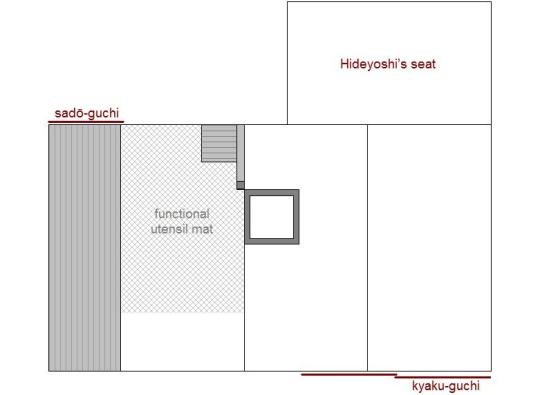
As an aside, Jōō’s and Rikyū’s small rooms had the guests enter through a pair of shōji panels which, while not full size, were still significantly higher than even the highest of the “classical” nijiri-guchi (which is the one installed in the Tai-an) -- meaning that there was no need to shuffle through the entrance in this way, nor any danger of accidentally elevating the torso too soon (and so hit the back of one’s head on the lintel of the door). The configuration of Rikyū’s actual Tai-an [待庵] is shown above.
Regarding the nijiri-guchi found on the Tai-an today, this was originally Rikyū’s naka-kuguri [中潜り], the sliding wooden door through which the guests stepped when passing into the fully enclosed inner-roji. In Rikyū’s rooms, the inner-roji was a small courtyard containing the chōzu-bachi and a roofed-over platform-like veranda (sometimes little more than a bench, though occasionally as large as one-mat in size) on which the guests sat during the naka-dachi (and by means of which they entered the tearoom by passing through the shōji that adjoined it).
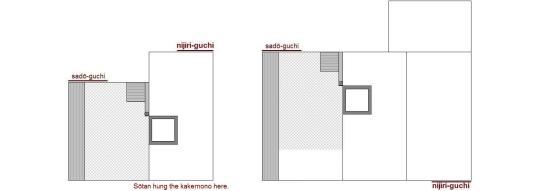
The naka-kuguri was installed as the nijiri-guchi by Sōtan’s son Kōshin Sōsa, when he remodeled the Tai-an so that it would more closely resemble Sōtan’s Fushin-an [不審庵] (shown above, on the left). Kōshin’s modifications to Rikyū’s Tai-an are shown on the right, with the way it was derived from Rikyū’s room is documented in the drawing below.

While Kōshin retained Rikyū’s original three-mat configuration, he reduced the width of the ita-datami onto which the original sadō-guchi opened, from Rikyū’s 1-shaku 8-sun 5-bu to the present 8-sun -- since this was the width of the ita-datami in Sōtan’s Fushin-an (even though the Fushin-an was, at that time, a 1-mat daime room). Reducing the width of the ita-datami necessitated a corresponding reduction of the width of the toko (in order to retain the same spatial configuration of the preparation area that functioned as the room’s mizuya), with its depth adjusted accordingly in order to maintain the Sen family’s preferred proportions.
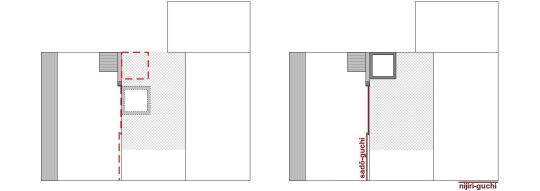
The complete repudiation of the original utensil mat, effected by erecting a pair of fusuma between the naka-bashira and the lower end of the mat, thereby turning Rikyū’s 3-mat room (that was used like a 2-mat daime) into the current 2-mat format, incorporating a sumi-ro of non-standard size (the ro that was used was the one that was supposed to be used in an inakama room, which tends to belie the argument that the person responsible for these changes was an expert in the Nampō Roku, as he claimed), occurred during the nineteenth century -- with the intention of making the room appear different from Omotesenke’s Fushin-an (primarily because the person who effected the changes had an intense personal animosity toward Omotesenke).

The only authentic portion of the present Tai-an is the tsuri-dana, and the sode-kabe (the wall on the right side of the photo) to which it is attached.
Rikyū’s tsuri-dana (the Tai-an was the first daime room that featured a tsuri-dana) had only a single shelf, as seen here; the tsuri-dana with two shelves was proposed (several years later) by Furuta Sōshitsu, while the one with three shelves was subsequently devised by Kobori Masakazu early in the seventeenth century. Rikyū’s sode-kabe lacked the fenestration at the bottom of the wall (this was another of Oribe’s creations, and one that is considered an important feature of the arrangement today). The wall on the far side of the tsuri-dana (to which the tsuri-dana is not attached) seems to have been replastered when the sadō-guchi was moved closer to the tsuri-dana (this became necessary when Kōshin Sōsa reduced the width of the ita-datami to 8-sun: the original sadō-guchi had opened fully onto the ita-datami, which Rikyū used as a sort of runway by means of which he walked to the lower end of the utensil mat, from where he bowed and greeted Hideyoshi at the beginning of his temae).
The rest of the room has been changed completely from anything that Rikyū himself would have recognized.
That said, if you search through the literature, you will find innumerable tomes by famous scholars that explain how Rikyū created and used the 2-mat room with its 1-shaku 3-sun sumi-ro [隅爐] (in other words, the room as it exists today, which is how it was reconstructed in the nineteenth century), all of whom will be very happy to discredit me and what I have written above with a red-faced vehemence. I first arrived at these conclusions, nevertheless, after a very, very careful and multi-yeared study of the measurements of the Tai-an -- since the wall between the sumi-ro and the tsuri-dana can only be interpreted as a sode-kabe, according to Rikyū’s own teachings on these measurements. Many years later, I also found the same argument made by the eminent Japanese art historian and scholar Ōkōchi Nobutake [大河内信威; 1902 ~ 1990] (in cultural matters, he is also known as Ōkōchi Fūsenshi [大河内風船子]), who carefully explored the evolution of this room in his own writings.
I decided to mention all of this here, even though it has nothing to do with the no-gaki no chakai, because it is an example that the reader should always keep in mind when listening to, or reading, the explanations of classical matters as interpreted by the modern schools and their affiliated scholars: the evidence in support of their assertions will usually be mountainous (yet a careful look will generally reveal that most of those books were written by the same small circle of proponents); but even if everyone is intent on arguing that a certain thing is true, that does not mean that it is necessarily historically factual. The schools, for all the arguments that they frame in such a way so as to suggest the contrary, are businesses; and, because chanoyu is a traditional activity, the way they strive to enlist new students is by claiming that they -- and they alone -- are the true and authentic representatives of the tradition. This is why, on the one hand, they burn incense to Rikyū, and swear by the veracity of the Nampō Roku (when something -- usually something in Book Seven -- supports their claims), and then zealously disavow his (historically authenticable) teachings as lies and fabrications (when they conflict with that school’s preferred way of doing something), on the other. The first six books of the Nampō Roku are largely true; and Book Seven is largely spurious.
³Seijō-keppaku wo moto to su [淸淨潔白ヲモトヽス].
Seijō-keppaku [淸淨潔白] means something like (be) pure in thought and deed*. It is a Buddhist aphorism, of the sort that became popular during the Edo period (the phrase is found in a text known as the Yo-ji juku-go [四字熟語], which was being used in the temple-schools to teach students to read kanji†).
Here it means that this idea of purity in mind and body is central (or, as it says, the fundamental principal -- moto [本]) to the no-gake. Perhaps because, historically speaking, no-asobi [野遊] seems to have not infrequently degenerated into a licentious sort of escapade (given that the area was usually surrounded by curtains -- rather like a boudoir -- and protected by a company of guards who all faced outward).
__________
*Kotobank (jp) explains the phrase in this way:
kokoro ga utsukushiku, okonai ni ushiro kurai-tokoro ga nai koto
[心が美しく、行いにうしろ暗いところがないこと].
This means “be noble and pure in heart, and have nothing dark in anything that you do.” Kurai-tokoro [暗い所] literally means a dark place (and could be understood in a similar way to the modern idiom “being in a dark place”). In a Buddhist context, this darkness usually suggests ignorance (of the True Way), being misguided, being deluded; a state of intellectual morbidity, rather than evilness of purpose. In other words, it is the antithesis of the clear-eyed state of enlightenment.
That said, in the context of the present entry, the expression seijō-keppaku is being used in a more mundane sense -- that is, when participating in a no-gake no chakai, we should keep our mind focused on what is pure, rather than allowing ourselves to be distracted by carnal thoughts or desires (as discussed in the second paragraph).
†I have been unable to find any reference to when this particular text was first used in Japan.
Books of this sort had been used in Korea since at least the Goryeo period, and remained popular tools (especially in the clan-based schools that were set up on the grounds of their Ancestor shrines) well past the middle of the 20th century. Many books of this sort (that show the influence of the Korean neo-Confucian-infused Buddhism) began to arrive in Japan beginning in the early Edo period (starting with Taku-an Sōhō [澤庵宗彭; 1573 ~ 1645], who arrived in Japan in 1603 -- according to Kanshū oshō, who was his direct descendant), though the book could have been brought to Japan earlier.
Taku-an’s intention was apparently nothing less than to undertake the reformation of Japanese Buddhism.
⁴Daizenji-yama, mata ha Chikuzen no Hakozaki-matsubara ni te Kyū no hataraki ni, matsukage naru-yue matsuba wo kaki-yose sawa-sawa to yu wo wakashi [大善寺山、又ハ筑前ノ箱崎松原ニテ休ノハタラキニ、松陰ナルユヘ松葉ヲカキヨセサハ〰ト湯ヲワカシ].
Daizenji-yama [大善寺山] is an area south of Fukuoka City, between the central mountains and pine barrens of the Chikugo river delta and the coast of the Ariake bay (or sea). The name suggests that, at some point in the past, a famous temple had existed in the region; but all physical traces of this institution have long been lost (the actual site of the temple complex seems to have been unknown in Rikyū’s day; and remains so today as well). The area had been under cultivation since ancient times (since the area had been part of the Gaya kingdom -- perhaps the original rice fields had been established by the Daizen-ji, or were being farmed under its purview), though apparently it had returned to the condition of a moorland by the time (in 1586~7) that Hideyoshi was prosecuting his campaign against the clans of Kyūshū -- in his efforts to incorporate the island into the Japanese nation.
Chikuzen no Hakozaki-matsubara [筑前の箱崎松原] refers to an area, now part of Fukuoka City north-east of the central business and political districts, that had originally been part of the extensive grounds of the Hakozaki-gū [筥崎宮], the important Shintō shrine dedicated to the God Yawata-no-kami [八幡神]*, the apotheosis of the semi-mythical emperor Ōjin [應神天皇].
Kyū no hataraki ni [休の働きに] means the subsequently related details (of raking the pine-needles into a mound that was then set ablaze and used to heat the kama) were Rikyū’s original idea.
Matsukage naru-yue matsuba wo kaki-yose [松陰なるゆえ松葉を掻寄せ] means because the site (selected by Rikyū for this more-or-less impromptu chakai) was in dappled shade beneath the pines, pine-needles were raked up.... The dappled shade implies that the area was forested with pine trees, under which would naturally be found a deep layer of pine-needles covering the ground. Wherefore it was perfectly natural for Rikyū to use them as fuel†, rather than charcoal.
Sawa-sawa to yu wo wakashi [爽々と湯を沸かし]: sawa-sawa to [爽々と]‡ means understandably, logically; yu wo wakashi [湯を沸かし] means to boil the hot water.
Though Shibayama’s text writes matsukage [松陰] as matsukage [松蔭], and wakashi [ワカシ = 沸カシ] as wakashi [湧シ], these are simply alternate ways of writing the same kanji-compounds. The sentences themselves are identical.
__________
*Now his name is usually pronounced Hachiman-jin [八幡神].
†By raking the needles into a mound, Rikyū exposed the damp ground in a circle around the fire. Doing so helped to prevent the fire from spreading out of control.
‡Sawa-sawa [爽々] is also used to mean refreshing, and also to mean clearly, unambiguously. While it seems that many commentators lean toward refreshing (because the text is describing an outdoor chakai), the context seems to demand understandably, intelligibly, or logically -- the idea to simply rake up a pile of pine-needles to use as fuel would follow naturally from the fact that the ground under the pine trees would be thick with pine needles.
⁵Waki-tatetaru shōfu no hito-koe, keburi no tachi-noboru-tei omoshiroshi-tote [ワキ立タル松風ノ一聲、烟ノ立ノボルテイ思白シトテ].
Waki-tatetaru shōfu no hito-koe [沸き立てたる松風の一聲] means when the boiling water raises its voice in the pine-wind(-sound)....
Kemuri no tachi-noboru-tei [烟の立ち上る躰]: kemuri [烟] means smoke, fumes (because only the top layer of pine needles are completely dry, the incorporated moisture will color the smoke white or pale-gray); tachi-noboru [立ち上る] means (the smoke) rises straight up; tachi-noboru-tei [立ち上る躰] means the smoke appears to rise like a pillar*.
Omoshiroshi [思白シ] appears to be either a miscopying, or one of those weird Edo period usages (where unexpected kanji were used as a way to confuse the uninitiated). The word should be omoshiroshi [面白シ] -- which would be omoshiroi [面白い] (“very interesting” or “very amusing”) today.
Shibayama’s version, other than exhibiting the same sort of kanji variants mentioned in the previous footnote, is identical to what is found in the Enkaku-ji manuscript.
__________
*This is all poetically fanciful.
Beneath pine trees, the smoke tends to spread out like a light mist, since the bows of the trees themselves create a very stable microclimate of still air. This is what shōfū [松風], “pine wind,” actually means: the air on the ground (and, indeed, up to the upper branches of the pine trees) is completely still and silent, so that one hears the wind blowing across the tops of the pines from a distance (which is a completely different sensual experience from being within the blowing wind itself).
⁶Denka sono-nochi no-asobi no on-toki ha, tabi-tabi, Kyū ni mo, Sōmu, Sōkyū ni mo, ka no fusube-chanoyu wo dashi-sōre to ōserare-shi yori, mina-hito fusube-chanoyu to iu-koto nari [殿下其ノチ野遊ノ御時ハ、タビ〰、休ニモ、宗無、宗及ニモ、カノフスベ茶ノ湯ヲ出シ候ヘト被仰シヨリ、皆人フスベ茶湯ト云コト也].
Denka [殿下] means “his highness” -- that is, Hideyoshi.
Denka sono-nochi no-asobi no on-toki ha [殿下その後野遊の御時は] means “after that his highness, on subsequent occasions when he was indulging in an outing (into the wilds)....”
Kyū ni mo, Sōmu, Sōkyū ni mo [休にも、宗無、宗及にも] names three of Hideyoshi's sadō [茶頭], tea officials, who appear to have attended upon him during excursions of this sort. In addition to Rikyū, these were Sumiyoshi-ya Sōmu [住吉屋宗無; ? ~ 1595]* and Tennōji-ya Sōkyū [天王寺屋宗及; ? ~ 1591]. All three men were prominent machi-shū chajin from Sakai.
Tabi-tabi...ka no fusube-chanoyu wo dashi-sōroe to ōserare-shi yori [度々...かの燻べ茶の湯を出し候えと仰せられしより] means “from time to time... this kind of ‘smoky chanoyu’ would be performed† when called for‡....”
The phrase ka no fusube-chanoyu [かの燻べ茶の湯] is important, because it means that Hideyoshi was requesting them to perform exactly the same kind of tea service that Rikyū spontaneously improvised on the earlier occasion -- that is, heating the kama by means of burning a mound of pine needles (rather than charcoal) underneath.
This suggests that it was Hideyoshi who either coined, or else was responsible for popularizing, the expression “fusube-chanoyu.”
Mina-hito [皆人] means all of the people, everyone. This expression appears to have been somewhat antiquated (at least by the eighteenth century).
Mina-hito fusube-chanoyu to iu-koto nari [皆人燻べ茶の湯と云うことなり] means “(based on that,) everyone started to call (no-gake) fusube-chanoyu.”
Here Shibayama's version has several very minor changes: denka sono nochi no-asobi-tō no seki ni te ha, tabi-tabi Kyū ni mo, sono-hoka Sōmu, Sōkyū ni mo, ka no fusube-chanoyu wo dashi-sōroe to ōserare-shi yori, hito mina fusube-chanoyu to iu nari [殿下其後野遊等ノサキニテハ、度〻休ニモ、其外宗無、宗及ニモ、カノフスベ茶湯ヲ出シ候ヘト被仰シヨリ、人皆フスベ茶ノ湯ト云フナリ].
Denka sono-nochi no-asobi-tō no seki ni te ha, tabi-tabi Kyū ni mo, sono-hoka Sōmu, Sōkyū ni mo, ka no fusube-chanoyu wo dashi-sōroe to ōserare-shi [殿下そののち野遊等の席にては、度〻休にも、その外宗無、宗及にも、かの燻べ茶の湯を出し候へと仰せられし] means “afterward, when his highness was indulging in pastimes such as outings, in those places he occasionally called out for [Ri]kyū, or the others -- Sōmu and Sōkyū -- to please bring out ‘that fusube-chanoyu.’” This qualifies that when Hideyoshi was calling out for fusube-chanoyu, his intention was that it be served on the spot, wherever he was (rather than having the party move to some other location that had been prepared beforehand).
Hito mina [人皆] (which reverses the two kanji so that we have “the people, all of whom...”) produces the same meaning. To iu [と云う] means “(they) said,” “(they) called (it);” to iu-koto [と云うこと] (as found in the Enkaku-ji manuscript) means “the situation where (they) said,” “the case where (they) called (it)....”
These changes will not have any impact on the meaning in English.
__________
*With respect to Sumiyoshi-ya Sōmu, his family business was the brewing of sake; and he had been initiated into the practice of chanoyu by Jōō (even though he was said to have been six or seven years younger than Rikyū).
He trained in Zen under Shun-oku Sōen [春屋宗園; 1529 ~ 1611].
†Dashi-sōroe [出し候え] more literally means “please bring out and do” (as in something that is brought out from one’s “bag of tricks”) -- something that is being held in readiness, so it can be enjoyed on the spur of the moment.
‡Ōserare-shi [仰せられし] means to call upon, or order (an underling) to please do something. In other words, on those occasions when Hideyoshi, spending the day hawking, or indulging in some other such pastime, he would occasionally order Rikyū, Sumiyoshi-ya Sōmu, or Tennōji-ya Sōkyū (whichever of these men were attending on him at that time -- all three were members of the group of eight chajin referred to as o-sadō hachi-nin-shū [御茶頭八人衆], whose function was to take charge of all tea-related matters on behalf of Hideyoshi) to serve tea in this way. (Which is why they would always have to be prepared -- since to have to send back to the base camp outside of Hakata for tea and utensils would have offended Hideyoshi severely.)
The o-sadō hachi-nin-shū [御茶頭八人衆] consisted of Imai Sōkyū [今井宗久], Tennōji-ya Sōkyū [天王寺屋宗及], Sen no Rikyū [千利休], Yama-no-ue Sōji [山上宗二], Jū Sōho [重宗甫], Sumiyoshi-ya Sōmu [住吉屋宗無], Mozu-ya Sōan [萬代屋宗安], and Sen no Dōan [千道安; who was also referred to as Shōan or Jōan, 紹安].
⁷Daizenji-yama ni te ha, shimo-michi no minami itchō-bakari, Hakozaki ni te ha Ebisu-dō no tō-hoku yon・go-chō, o-chasho wo kamae, matsu ni unryū-gama wo tsuri, chabako wo hiraku to Kyū no oboe-gaki ni mo ari [大善寺山ニテハ、下道ノ南一町バカリ、箱崎ニテハヱビス堂ノ東北四・五丁、御茶所ヲカマヘ、松ニ雲龍釜ヲツリ、茶箱ヲヒラクト休ノヲホヘ書ニモアリ].
Daizenji-yama ni te ha, shimo-michi no minami itchō-bakari [大善寺山にては、下道の南一町ばかり]: Daizenji-yama ni te [大善寺山にて] means in the (region of) Daizenji-yama; shimo-michi [下道の南一町ばかり] refers to lower of the two the ancient post roads that connected Daizaifu [太宰封] (the ancient capital of Gaya) with the port on the Bay of Ariake -- many years ago I was told that the modern Tenjin-Omuta Line basically follows the course of that road (while the shinkansen follows the upper road); shimo-michi no minami itchō-bakari [下道の南一町ばかり] means 1-chō (a measure of distance of around 109 meters, so a square of roughly that size would have been curtained off) south of the post road*.
Hakozaki ni te ha Ebisu-dō no tō-hoku yon・go chō [箱崎にては惠比須堂の東北四・五町] means an area of 4- or 5-chō to the north-east of the Ebisu-dō† -- this is a reference to the Tamatori Ebisu-jinja [玉取恵比須神社], one of the shrines within the greater Hakozaki-gū: it was located on the north-eastern edge of the complex. In Rikyū’s day, the entire area surrounding the Hakozaki-gū was covered by an ancient pine-barren, so what this means is that an area of some 4- or 5-chō (roughly half a kilometer square) was enclosed by curtains, to establish Hideyoshi’s tea-drinking area.
O-chasho wo kamae [御茶所を構え] means (Hideyoshi's) place for (drinking) tea was enclosed in the manner shown in the photo, below‡ -- in other words, areas of the sizes mentioned in the above descriptions were enclosed by hanging red and white striped curtains around the periphery (with guards stationed on the outside, to provide security).

Matsu ni unryū-gama wo tsuri, chabako wo hiraku to [松に雲龍釜を釣り、茶箱を開くと] means the unryū-gama was hung from a pine tree, and a tea-box was opened (to reveal the utensils it contained).
Rikyū’s cha-bako is shown below.

This box measures approximately 8-sun by 5-sun, and is 4-sun 5-bu high. It appears to have been made in Thailand. It would have been imported for use as a te-bako [手箱] (a box small enough to be carried in the hands, in which people like courtiers -- both men and women -- carried their cosmetics, and other small items that they might need throughout the day when on court duty). When used for serving tea, the box (which contained the chawan, prepared with chakin, chasen, and chashaku already arranged in it, together with the chaire, tied in its shifuku) was simply opened, and the utensils it contained lifted out and arranged on thin pieces of wood that were spread out on the ground to receive them. There was nothing resembling a modern cha-bako temae; and tea would have been served in the usual way.
If a stream flowed through the enclosure (as there was, at least, in the Daizenji-yama o-chasho), the kama would be filled directly from the stream -- which would also take the place of a mizusashi (and koboshi)**.
Kyū no oboe-gaki ni mo ari [休の覺書にもあり] means that a discussion of the fusube-chanoyu will also be found in the Book One of the Nampō Roku -- the Oboe-gaki [覺書] book that memorializes some of Rikyū’s stories and teachings††. This reference, however, is a little confusing, since it implies that the Oboe-gaki book was written by Rikyū, where it is actually a record of Nambō Sōkei’s recollections -- while most of the things discussed in Book One are related to Rikyu and his teachings, this is not true of everything.
For the last part of this sentence, Shibayama’s toku-shu shahon has matsu ni kusari ni te unryu-gama wo tsuri, chabako wo hiraku to, Kyū no oboe-gaki ni mo ari [松ニクサリニテ雲龍釜ヲツリ、茶箱ヲヒラクト、休ノ覺書ニモアリ].
The only difference is that this version qualifies that the unryū-gama was suspended from the pine tree on a chain (kusari [鏁]) -- which would be much easier to carry than a take-jizai [竹自在] (even though it would be “less wabi” than the latter).
__________
*The old post road ran roughly east to west in this area. The most likely location would have been on the bank of the Hiro-kawa [廣川], or one of its tributaries (since this would have eliminated the need for a mizusashi).
As this gathering was completely impromptu, Rikyū, Hideyoshi, and the other members of their party, would have squatted down on the ground, and prepared and drunk tea in that way.
†Ebisu [惠比須] was the Shintō god of fishing and commerce (enterprises that took place on the open ocean). As such he was of great importance to the townsmen of both Sakai and Hakata.
Ebisu [夷], as it is written in Shibayama's toku-shu shahon, is one of several hentai-gana ways to render the name of this God.
‡This was done by hanging red and white striped curtains (called kō-haku no maku [紅白の幕]) around the periphery. A phalanx of Hideyoshi's personal guards would have been stationed on the outside of these curtains, to provide the occupants with security. (Remember, Nobunaga met his untimely end because he did not have adequate security surrounding the Honnō-ji when indulging in chanoyu.)
**The host’s seat would be oriented so that, crouching down near the ground, he would be facing upstream, on the bank of the river. Cold water would be dipped directly from the river using a hishaku -- and used water would be poured into the river, too (which is why the host’s orientation was so important).
††Please refer to the two posts that were cited (and linked) in the first sub-note under my introductory remarks, immediately following the translation.
⁸Tadasu ni te no toki ha, yashiro [h]e mairu naka-michi, ko-matsubara no ryū no atari nari [タヾスニテノ時ハ、社ヘ參ル中道、小松原ノ流ノ邊也].
Tadasu [糺] is a reference to Tadasu no mori [糺森] (the Grove of Rectification), a wooded area located just north of the confluence of the Takano and the Kamo rivers, within the precincts of the Lower Kamo Shrine (Shimo-gamo-jinja [下鴨神社]), in Kyōto, where a no-gake chakai was hosted by Rikyū in 1587.
Tadasu ni te no toki [糺にての時は] means on the occasion when (the chakai was hosted) in the Tadasu(-no-mori)....
Yashiro [h]e mairu naka-michi, ko-matsubara no ryū no atari nari [社へ參る中道、小松原の流の邊なり] means on the middle of the paths leading to the shrine, (Rikyū served tea) beside the small stream that flows through the grove. This rill (ryū [流]) is seen in the photo*.
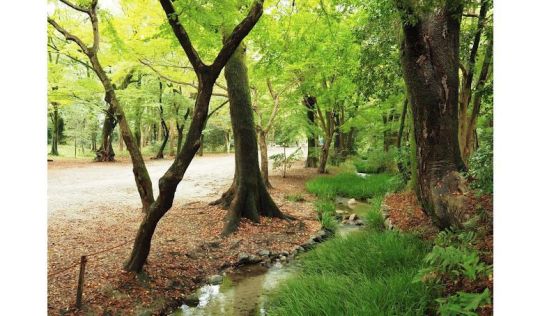
This is referring to a chakai that Rikyu hosted at dusk on the last day of the Sixth Lunar Month of Tenshō 15 [天正十五年六月晦日]† (August 3, 1587), which was the 29th day of that month, the day of preparation for the Kamo festival.
__________
*It was probably because of the small size of the stream, and the fact that the stream flows first through the shrine itself (with many people having been passing through the grounds on that day of preparation), that Rikyū chose to bring water in a sugi te-oke [杉手桶], rather than dip it straight from the stream. (The fact that the chakai would take place in the evening may have also figured into his calculations, since exposed water was said to become poisonous after dark.)
†Please see the post entitled Nampō Roku, Book 2 (42): (1587) Sixth Month, the Last Day, Evening for illustrations of the various utensils that Rikyū used, as well as other details of that occasion. The URL for that post is:
https://chanoyu-to-wa.tumblr.com/post/183858107433/namp%C5%8D-roku-book-2-42-1587-sixth-month-the
This gathering was likely cited here (as a way to give veracity to his assertioins) because the author of this entry had no other information regarding Rikyū’s activities -- but what could be found in the Nampō Roku itself.
⁹Sono-toki made ha matsu mo nashi, san-bon take ni te kama-kakerare, mizu-chikaki yue, mizusashi nashi ni hataraki tamau nari, chakin kama no futa ni okare-shi-koto wo, aru hito toi-keru ni, kono ichi-e no kokoro ha sayō no koto ni te ha nashi [其時マデハ松モナシ、三本竹ニテ釜カケラル、水近キユヘ、水サシナシニハタラキ玉フ也、��巾釜ノフタニヲカレシコトヲ、アル人問ケルニ、コノ一會ノ心ハサヤウノコトニテハナシ].
Though it would have been easy to divide this very long sentence into several separate footnotes, I hope my reasons for dealing with it as a unit will become clear as you read the commentary.
Sono-toki made ha matsu mo nashi [その時なでは松もなし] means “up to that time, if there were no pine trees (from which the kama could be suspended)....”
San-bon take ni te kama-kakerare [三本竹にて釜懸けらる] means “the kama may be hung from three lengths of bamboo.”
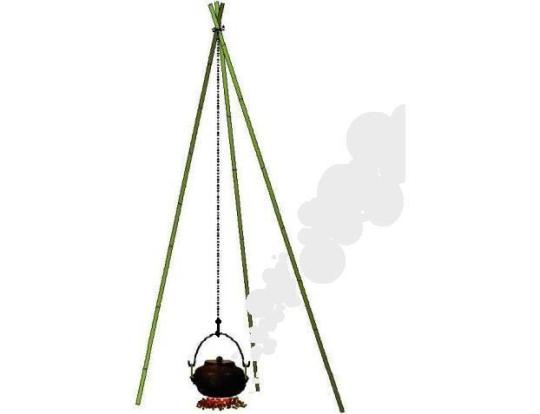
A structure like this had been used since ancient times to create stands for kagari-bi [篝火] (garden lights -- the word is sometimes translated garden torches or garden flares -- consisting of a metal basket filled with burning brushwood). While this basket was placed in the crotch above the three poles, here the kama was suspended below them, with the fire kindled in the middle of the tripod. This was probably the first way that the kama was arranged for no-gake (hence its name) -- with the kama being suspended from a pine tree appearing much later (it is certainly possible that the episode at Daizenji-yama mentioned above was the first such occasion for this arrangement).
Mizu-chikaki yue, mizusashi nashi ni hataraki tamau nari [水近いゆえ、水指なしに働き給うなり] means if water (is flowing) nearby, it is said that you can do things without a mizusashi....”
Chakin kama no futa ni okare-shi-koto wo [茶巾釜の蓋に置かれしことを] means “...in which case the chakin should be placed on the lid of the kama.”
Aru hito toi-keru ni, kono ichi-e no kokoro ha sayō no koto ni te ha nashi [ある人問けるに、この一會の心業ようのことにてはなし] means “when a certain person asked about this, (questioning) the thinking behind the way things were done at this one gathering, with respect to that (matter)*, (he suggested that) it should not have been done.”
In other words, this person has taken offense, since he believed that placing the chakin on the lid of the kama was something that should only be done when that chakin would not be used again (in other words, when the chakin was being “thrown away” -- as per the arguments made in entry 64). Yet on this occasion, when there was no mizusashi, Rikyū placed the chakin on the lid of the kama over the course of the whole temae. That is, the quisitor is implying that Rikyū either made a foolish mistake, or was being disrespectful of the proprieties. In the Enkaku-ji version of this story, Rikyū does not actually make any reply.
Shibayama’s text is the same except for the final phrase in this sentence. His toku-shu shahon ends the sentence: aru-hito toi-keru ni, kono ichi-e ni oite ha susugi-kiyomuru-koto cha-gu nomi narazu [或人問ケルニ、此一會ニ於テハスヽキ淸ムルコト茶具ノミナラズ]. So, rather than questioning why the chakin could be placed on the lid of the kama throughout the temae, here his interlocutor seems to be asking about the matter of purifying the utensils (the chawan, chakin, and chasen) by rinsing them in water. To this comes the reply (whether from Sōkei or Rikyū is not clear in this version): “it is not only the utensils that should be rinsed so they are pure†.” (Implying that the idea of purity extends also the the mind of the host and his guests.)
However, here Tanaka’s genpon text developes this idea even further. The whole sentence that we are considering in this footnote is given as follows: sono-toki made ha matsu mo nashi, san-bon take ni kama kakeraru, mizu chikaki yue ni, mizusashi nakereba, chakin wo kama[-no-]futa no ue ni oku wo tori-mama kama no futa ni okaruru, sono shisai toi-bito ari, Kyū no iu, kono ichi-e ni oite, susugi-kiyomuru-koto, chagu nomi narazu [其時マデハ松モナシ、三本竹ニテ釜カケラル、水近キ故ニ、水指ナケレバ、茶巾ヲ釜蓋ノ上ニヲクヲ取マヽ釜ノフタニヲカルヽ、其子細問人アリ、休ノ云、コノ一會ニ於テ、スヽキ淸ムル事、茶具ノミナラズ].
This means: “if, on that occasion, there were no pine trees, the kama would be hung from three lengths of bamboo; and if, because [flowing] water is [available] nearby, and so a mizusashi has been dispensed with, the chakin is placed on the lid of the kama, used as it is‡, and then put back on the lid of the kama [afterward]. Someone asked about the details of this, to which [Ri]kyū replied: ‘in this particular gathering, with respect to the matter of purifying [the utensils] through rinsing [them], it was not only the things that were used to prepare tea [that were so purified].’”
Rikyū’s explanation seems to be that it is not only the utensils that should have been cleaned, but also the minds of the host and guests as well. When their minds have been purified, they are no longer contaminated by the dust of the world. So, being pure, they perceive the world as pure -- thus, for such people, the question of purity and defilement ceases to exist. The lid of the mizusashi is not especially pure, nor is the lid of the kama unclean**. Both are extensions of this pure world, so the lid of the kama will be as pure as everything else.
__________
*The reference seems to be to using water dipped from the stream, in place of a mizusashi.
The actual thinking is unclear, but the author appears to have been misinformed about Rikyū’s evening chakai in the Tadashi-no-mori, if that is the fusube-chakai to which he is referring -- because, for whatever reason, Rikyū chose to bring the water in a sugi-teoke, rather than dipping it out of the stream, and so used the sugi-teoki as his mizusashi during that gathering.
As explained in the previous footnote, this stream is rather small, and flows through the shrine before passing through the Tadasu-no-mori (and eventually being discharged into the Kamo River at the end of the little peninsula on which the shrine is located). Thus, Rikyū may have felt that the water in the stream would not be especially pure (in that time it was not unusual for men to urinate freely into any stream or gutter when necessary, which is why residences in Kyōto erected arching bamboo grates along their street-facing walls -- to keep men a safe distance away -- since urine would cause the plaster to break down).
Furthermore, as was also mentioned above, he may have felt that exposed water becomes charged with poisons after dark, making it unsafe to use regardless of the civic-mindedness of the local population. (The water in the sugi-teoke would have been drawn at dawn; and the cryptomeria wood from which the bucket was fabricated was understood to be purifying of the contents as well.)
That all being said, the point appears to be that the author of this entry imagined that Rikyū did not use a mizusashi on that occasion, and so placed the chakin on the lid of the kama throughout the whole temae -- and it was this behavior that the quisitor was rejecting (phrasing his objection as a question).
†Implying that the purity of the utensils should be our least concern (even though they should be spotlessly pure as a matter of course). The importance of a pure heart is one of the central themes in writings about chanoyu theory, an aspect of chanoyu that was being emphasized during the first half of the Edo period, in the wake of Taku-an Sōhō’s teachings on the relationship between Tea and Zen.
At this point in his commentary, Shibayama directs our attention to the text of the original entry (cited above under the introductory notes) in Book One, which reads, in part: shu-kyaku no kokoro mo sei-jō keppaku wo dai-ichi to su iu-iu [主客ノ心モ淸淨潔白ヲ第一トス云〻]. This means “with respect to the hearts of both the host and (his) guests, it is said that they should be pure in both thoughts and deeds” (please refer to the discussion of sei-jō keppaku [淸淨潔白] in footnote 3, above).
Furthermore, he goes on, in entry 19 in the Sumibiki no uchinuki-gaki・tsuika [墨引之内拔書・追加], it says: chakin, chasen ika ni mo mizuke no sawa-sawa to miyuru-yō ni shite iu-iu [茶巾、茶筌イカニモ水ケノサハサハト見ユル様ニシテ云〻]. This means “as for the chakin and chasen, always make them appear fresh and clean [by rinsing them] with water -- so it has been said.”
‡More literally, tori-mama kama-no-futa ni okareru [取りまま釜の蓋に置かれる] would mean taken up as it is, and (then) placed on the lid of the kama (afterward). In other words, in the absence of a mizusashi, the chakin is placed on the lid of the kama at the very beginning of the temae (when the host is emptying the chawan of the chasen and chakin, in preparation for the first rinsing and chasen-tōshi), and then taken up from there (when it is needed to dry the chawan) and returned there afterward.
Again, this is describing the temae in Sen family terms (where the lid was handled with the bare fingers). In Rikyū’s temae, as has been explained before, the chakin was used to protect the fingers when lifting off the hot lid, and then rested on the lid immediately.
But this would then raise the question of what to do with the chakin when the lid of the kama was closed (during the chasen-tōshi) so as to heat the water fully in anticipation of the preparation of koicha. Of course, in the case of the evening chakai in the Tadashi-no-mori that is cited as an example, Rikyū used a sugi-teoki as his mizusashi (rendering this question moot); but in the absence of a mizusashi -- such as when Rikyū was called upon to spontaneously spontaneously serve tea during Hideyoshi's outing to Daizenji-yama -- perhaps Rikyū only served usucha (which would make the closing and reopening of the lid of the kama unnecessary). Indeed, during such an outing (which was probably for hawking, one of Hideyoshi’s favorite outdoor activities), koicha would have been inappropriate, since the idea was to quench Hideyoshi’s thirst -- which would account for Hideyoshi’s impressed surprise at the way Rikyū chose to do things (and why he subsequently called out for “fusube-chanoyu” on other occasions of the sort).
**This idea that the lid of the kama is inherently unclean appears to be unique to the machi-shū tradition espoused by the Sen family (I have heard it said there, but it is not included in the teachings of those schools that do not have such a connection). As was explained in entry 64, Rikyū used the chakin to protect his fingers when opening the lid of the kama, and it remained resting on the lid until it was time to close it again. This was the gokushin way of doing things -- and this established the precedent that he used on occasions when there was no mizusashi.
¹⁰Isshin no sho-i ni shite, te-waza no shōji ni arazu, mazu yoku-tanren no ue, monjin-serare-yo to no tamau [一心ノ所爲ニシテ、手ワザノ小事ニアラズ、先能煆煉ノ上、問訊セラレヨトノ玉フ].
Sho-i [所爲] means an action, a deed. So isshin no sho-i ni shite [一心の所爲にして] means to do something with one’s whole heart*.
Te-waza no shōji ni arazu [手業の小事にあらず]: te-waza [手業] means something that is done with one’s own hands (i.e., a physical effort); shōji [小事] means trivial, insignificant. So, “what we do with our own hands is not unimportant.”
When we do something wholeheartedly, our actions can never be trivial: even the most insignificant gesture will be full of power.
Mazu yoku-tanren† no ue, monjin-serare-yo to no tamau [先ずよく鍛練の上、問訊せられよとの給う]: mazu [先ず] means first, right away; yoku-tanren no ue [よく鍛練の上] means advanced beyond a state of mastery‡; monjin-serare-yo [問訊せられよ] means (you) should question (your own capabilities); to no tamau [との給う] means (this teaching) has been handed down (to us).
Here, Shibayama’s and Tanaka’s texts include only the first phrase (isshin no sho-i ni shite [一心ノ所爲ニシテ]), after which they launch off in a different direction (their version -- which is discussed in footnotes 11 and 12 -- has been included in the translation of the entry, enclosed in doubled brackets).
__________
*Shibayama argues that this is the main idea that underpins the (successful) staging of a no-gake no chakai.
Here he again quotes from entry 32 in Book One to support this contention: shutsuri no hito ni arazu shite ha nari-gatakaru-beshi [出離ノ人ニアラズシテハ成ガタカルベシ] -- which means, “if one is not [like] a person who has renounced the world, aspiring to [stage a no-gake no chakai] should be all but impossible.” This reflects the state of chanoyu theory (which developed in response to Takuan Sōhō’s teachings, as discussed above) that was popular among the machi-shū followers of the Sen family around the end of the seventeenth century.
†In the entries that were written by the author of the present section (who appears to have been affiliated with the Sen family’s machi-shū tradition of chanoyu), tanren [鍛練], which refers to training or discipline (in the sense of one’s level of skill or mastery of the practice), is invariably written tanren [煆煉]. The reader should be careful, therefore, when approaching the original texts, because this unrecognized variant may prove confusing (since most dictionaries do not recognize the equivalency between these two written forms).
‡In other words, once we have mastered everything (at least at our level), we should immediately look back and reflect on our attainments, questioning whether we truly understand.
This reflection and self-criticism was considered especially important around the time that this entry was written (in the late seventeenth century).
¹¹Hito-bito no kokoro tomo ni aka ha aru-majiki ni, sono fushin dai-no-kegare nari [人〻ノ心共ニ垢ハアルマシキニ、其不審大ノケガレナリ].
This and the following sentences (footnote 12) are found only in the toku-shu shahon and genpon versions of the text.
Hito-bito no kokoro tomo ni aka ha aru-majiki [人々の心ともに垢は有るまじき] means the hearts of all people should not be sullied.
Sono fushin [その不審] means to be ignorant of that (principal)....
Dai no kegare nari [大の穢れなり] means (this ignorance is) a grave disgrace.
¹²Ji ni okite mo kegare ha naki hazu no shōjō-shin ni nari-sōrō ha de ha, kono ichi-nen no kokoro ha satori muzukashigaru-beshi to iu-iu [地ニ置テモケガレハナキ筈ノ淸淨心ニナリ候ハデハ、此一念ノ心ハ悟リ難カルベシト云〻].
Again, this sentence is found only in the toku-shu shahon and genpon texts. However, these two versions differ in their second phrases.
Ji ni okite mo kegare ha naki hazu no shōjō-shin ni nari sōrō ha [地に置きても穢れはなき筈の清浄心になり候は]: ji ni okite [地に置きても] means even if (it)* is placed onto the ground; kegare ha naki hazu [穢れはなき筈] means it will not be expected to become sullied; shōjō-shin ni nari-sōrō [清浄心になり候] means if the heart has been purified†.
De ha [では] means then, therefore, to my mind, in my opinion, as for, in which case, and so forth. In other words, the second phrase derives from, or is an exposition of, the first.
Shibayama’s version continues: ono ichinen no kokoro wa satori nan karubeshi to iu-iu [この一念の心は悟り難かるべしと云〻], which means “the mind of this single nen [念]‡ is difficult to comprehend.”
As suggested abover, Tanaka’s genpon text differs in the second phrase of this sentence, which reads: [コノ一會ノ心ハ悟リガタカルベシト云也、大和尚モ一座感心不斜、同人口ヲツグム].
Kono ichi-e no kokoro ha satori-gatakaru-beshi to iu nari [この一會の心は悟り難かるべしと云うなり] means the mind of this one gathering is difficult to understand, so it is said. (This is because, as argued above, only a man of pure mind will be able to stage a no-gake no chakai successfully**.)
Dai-oshō mo ichi-za kanshin naname-narazu [大和尚も一座感心斜めならず] means it is extraordinary when even a group of great monks are all moved to admire (something). In other words, even people who are supposed to be enlightened will not be uniformly impressed by something, regardless of how moving it might be to others of them.
Dō-jin kuchi wo tsugumu [同人口を噤む]: here, dō-jin [同人] seems to mean the other people (whether the other monks, or the other guests if there were any) should keep quiet.
The guests should not argue among themselves. They should accept the host’s arrangements in the spirit in which they were done.
__________
*Whether the author intended this “it” to refer to the utensils, or to the heart of the host, is unclear.
†Perhaps more literally, “if the purified heart has come into being.”
It appears that the argument being made here is that only a person who is profoundly enlightened will be able to stage a no-gake no chakai with any hope of success. And it is only persons of the same sort who will be able to appreciate the host’s efforts fully.
This is a manifestation of the Edo period mentality that chanoyu was so mysterious that it was simply beyond the imagination of mere mortals -- hence the need for careful and deliberate guidance from the professional masters, who were the living embodiment of Rikyū’s spirit.
‡In Buddhist theory, a nen [念] is a single unit of thought. Our perception is based on our interpreting the series of nen that continue to flow incessantly (perception requires that the original nen is observed, and then analyzed; and it is this analysis that we understand to be experience -- even though it is two nen removed from actuality). For this reason, it is said that it is impossible to comprehend a single nen. And if that is so, how much more difficult will it be for us to fully understand something so long in time as a full chakai?
According to this way of thinking, samadhi is the direct experience of the flow of nen -- without the intervening analysis.
**Though the reason is not really explained in this entry, it is because this kind of gathering is performed out-of-doors. Since there are no physical walls to keep the minds or attention of the guests from wandering, it is exceptionally difficult to maintain the sort of tension that holds an ordinary gathering together.
Modern chajin occasionally use the kō-haku no maku (the red-and-white striped curtains that are hung up on the periphery of the area where the chakai will be staged) in an effort to create a sort of chaseki, but this was really not their original purpose. Rather, their purpose was to close off a large area (at Daizenji-yama, the enclosed area was the same length as, but somewhat wider than, a regulation soccer pitch or football field; while in the pine barrens at Hakozaki, it was 4 to 5 times larger -- and the curtains would be all but out of sight of the guests who were participating in the chakai), so that anyone who was not associated with the gathering would be unable to approach (whether out of curiosity, or for more nefarious purposes).
This is why, for example, in entry 31 of Book One, Rikyū is quoted as saying:
keiki ubawarete chakai shimanu-mono nari, besshite kyaku no kokoro motomaru-yō ni suru hon-i nari, sore-yue, dōgu mo besshite hizō-no-chaire nado yoshi
[景氣ニウバヽレテ茶會シマヌモノ也、別而客ノ心モトマルヤウニスル本意也、夫故、道具モ別而秘藏ノ茶入ナドヨシ].
This means “if the [beauty of the] scenery is overpowering, the chakai will be unable to maintain its grip [on the guests’ interest]. Therefore [the host] should make an especial [effort] to try to catch the guests’ attention -- this is the real reason [for everything that the host attempts to do]. Consequently, with respect to the utensils, it is better to [use] a greatly treasured chaire, or other things of that sort”.
¹³Asa-asashiku kono-bō nado no e-toku ni te tsukamatsuru-beki koto ni arazu [淺〻シクコノ坊ナドノ會得ニテ仕ルベキコトニアラズ].
Asa-asashiku [淺〻しく] means extremely shallow (in this case, referring to the Nambō Sōkei’s understanding).
Kono-bō nado [この坊など] would be translated “this monk, and the others...,” “this monk, among other people...,” or perhaps “this monk, as well as the other people....”
The unnamed “others” being the expected readers of the book (those with enough experience of chanoyu that they would be able to begin to doubt their own level of competence -- as discussed in footnote 10).
Consequently, asa-asashiku kono-bō nado no e-toku ni te [淺〻しくこの坊などの會得にて] means “in the case of the understanding of this monk, and others....
Tsukamatsuru-beki koto ni arazu [仕るべきことに非ず] means “(it) will not serve (to allow us to stage a no-gake no chakai -- at least without assistance).”
Of course the point is to discourage “ordinary people” (including those who had gotten all of their menjō [免状]) from attempting to do so, especially by themselves. It was from this time that the practice of asking one’s teacher, or his or her senior disciple, to help in the katte began to become common -- since no one could presume to do things by himself. Indeed, the training offered by the modern schools dictates that a tea gathering -- whether for a small group of guests, or an ō-yose-chakai where a number of separate seki will be held over the course of a day (or longer) -- must always be a group effort. The host (no matter how experienced) should never attempt to do it completely without assistance.
==============================================
❖ Appendix: Tanaka Senshō’s Thoughts on this Entry.
“In the preceding entry, the issue of discarding or not discarding the chakin [by placing it on the lid of the kama] was raised. This is something connected with the worldly practices associated with the daisu. But, following from [the idea of] cha-zen ichi-mi [茶禪一味]¹⁴, we must realize that this world [of wabi no chanoyu] is [inherently] pure and unsullied.
“[To say] the top of the lid of the mizusashi is clean, and the lid of the kama is unclean, this is a reflection of relativistic thinking¹⁵. The entire roji [including the setchin] is uniformly pure. Isn't it like Ikkyū oshō’s saying: ‘exposing the crack of your buttocks in the bath, how can we speak of clean or dirty?¹⁶’ -- isn’t this so?
“In the roji, we handle the zōri that we wore on our feet [with out bare hands¹⁷]. We put our hands on the surface of the tatami when we perform our bows. And then we pick up the chakin with the same hands, and [with those same hands] we prepare the tea.
“In this pure world [of the roji and tearoom] there is nothing that is unclean. Yet the mind that thinks about impurity -- isn’t that mind already defiled? The heart of that person who asked [about the propriety of placing the chakin on the lid of the kama when serving tea out-of-doors without a mizusashi]: is this not evidence that dust was already clinging to his heart? Rikyū's stern reply¹⁸ impressed everyone who was present; but as for the quisitor, he should have kept his mouth shut.
“A very interesting story, isn’t it¹⁹?”
_________________________
¹⁴Cha-zen ichi-mi [茶禪一味] means both tea and zen have the same flavor. In other words, in essence, they are the same.
¹⁵Ni-ken [二見] is a Buddhist term that refers to contrasting or dualistic ideas: transience versus permanence, existance versus non-existance, purity versus impurity, and so forth.
¹⁶People often quote Ikkyū as saying “nothing is pure, nothing is dirty” (or words to that effect), but here the words are put into their original context.
¹⁷Today a piece of kaishi is held between the fingers and the strap of the zōri, but it seems that this practice arose only during the early 20th century, at the time when chanoyu was being codified in minute detail -- in anticipation of the arrival of hoards of young women who would be forced into the practice by their parents (to make them “more marriageable”). Since one of the rules they were being taught was to always be clean, the traditional way of handling the zōri with the bare fingers begged to be “corrected.” Hence the idea of using a piece of kaishi, for protection (since the hands cannot be washed afterward, because the person is at that moment entering the tearoom).
¹⁸This is referring to footnote 9, where the genpon text reads (in translation): “if, on that occasion, there were no pine trees, the kama would be hung from three lengths of bamboo; and if, because [flowing] water is [available] nearby, and so a mizusashi has been dispensed with, the chakin is placed on the lid of the kama, used as it is, and then put back on the lid of the kama [afterward]. Someone asked about the details of this, to which [Ri]kyū replied: ‘in this particular gathering, with respect to the matter of purifying [the utensils] through rinsing [them], it was not only the things that were used to prepare tea [that were so purified].’”
As explained under that footnote, the idea seems to be that it is not only the chawan, chakin and chasen that have been rinsed clean, but also the kama and its lid, too*. That is why the chakin can be placed on the lid with impunity, and why it can be used and returned (and used again later) without the host having to continually refold it.
__________
*Though here Tanaka seems to be considering purity as less a physical state than an intellectual one. In other words, he implies that the lid of the kama is pure in the same way as the entirety of the roji is pure (including the toilet) -- whether or not the host has specifically rinsed it.
While it was usually the custom not not wet bronze lids (because, depending on the pH and/or mineral content of the water, it could sometimes cause the bronze to become discolored, leaving spots or corrupting its color or patina), the small unryū-gama that Rikyū was carrying around with him had an iron lid, and this lid was rinsed along with the kama when it was being prepared for use.
¹⁹The complete text of his comments is as follows:
Zen-jō ni oite, chakin wo sutsuru-sutenu no mondai ga atta. Kore ha seken-teki no daisu shikkō no koto de aru. Shikaru ni, sude ni cha-zen ichi-mi no ue ni oite ha, shōjō-muku no sekai wo satoraneba naranu. Mizusashi no futa no ue ga sei-ketsu ja no, kama-futa no ue ha fuketsu ja no to ni-ken ni watarite ha naranu. Ichi-yō no haku-roji de aru. Ikkyū oshō no ‘shiriatama wakete miyokashi furo no naka, kiyoshi kitanashi iu koto mo nashi’ de ha nai ka. Roji de ha, ashi ni haku-zōri wo sashi de tsumu. Tatami no ue ni te wo tsuite o-jigi wo suru. Sono-te de chakin wo tsumi, cha wo tateru. Kono seijō-sekai ni fu-jō ha nai hazu ja. Fu-jō nari to omou-kokoro ga, sude ni kokoro no kegare de ha nai ka. Sa-yō na shitsu-mon wo suru hito no kokoro ha, sude ni hokori ga fuchaku-shite-iru shōko ja to, Rikyū no te-kibishii kotae ni, ichi-za mina kanshin shita. Toi-sha mo mata, kuchi wo kanshita to. Omoshiroi hanashi de ha nai ka.
[前条に於て、茶巾を捨つる捨てぬの問題があつた。是は世間的の台子執行の事である。然るに、既に茶禅一味の上に於ては、清浄無垢の世界を悟らねばならぬ。水指の蓋の上が清潔ぢやの、釜蓋の上は不潔ぢやのと二見に渉りてはならぬ。一様の白露地である。一休和尚の「臀頭分けでみよかし風呂の中、清し汚し云うこともなし」ではないか。露地では、足に履く草履を指で摘む。畳の上に手をつぃて御辞儀をする。其手で茶巾を摘み、茶を点てる。此清浄世界に不浄は無い筈ぢや。不浄なりと思ふ心が、既に心の污れではないか。左様な質問をする人の心は、既に塵埃が付着して居る証拠じゃと、利休の手厳しい答えに、一座皆感心した。問者も亦、口を緘したと。面白い話ではないか].
0 notes
Text
Barbecue in the pool

Osaka: Barbecue Restaurant Opens Inside Old School Swimming Pool
Japan is running out of children, and schools across the country are having to close. What to do with the empty buildings? A visit to Osaka where they came up with something special.
At first, innkeeper Hajime Otsuki found his new workplace a bit scary. After all, it wasn't that long ago that the 27-year-old went to school and was exposed to Japanese horror culture. "As a child, I heard stories about ghosts at school," the Gakkou no Kaidan[1] that children and young people in the island state like to tell to scare each other a little. That's what Otsuki had to think about when he started working for the barbecue restaurant Ikuno BBQ Skypark. Because it is housed in a disused Miyukimori Elementary School in the Ikuno district of the city of Osaka. More precisely: on the roof of the school. To be more precise: in the swimming pool on the roof of the school.
Japan is the oldest society in the world. According to data from the Tokyo government, almost 30 percent of the 125 million people in the island state are 65 and older. The proportion of older people is growing, there are fewer and fewer young people. As a result, schools have to close. Angular buildings remain that the authorities and investors do not want to abandon without a fight.
So make something out of it, school building recycling is on the rise. They are renovated and reused as hotels, wellness facilities, museums or restaurants. Especially in Japan's hinterland, which is badly affected by the aging population. "Staying overnight in closed schools is just fun!", the travel portal travel.jp titled an article with examples from Gunma, Akita and other prefectures. The coastal town of Muroto[2] in Kochi advertises its "schoolhouse aquarium"; where primary school children once crammed, you can now see hammerhead sharks, sea cucumbers and sea turtles. And in Mihama-chō[3], Fukui Prefecture, the site of a nuclear power plant, a closed school is being used as a public "Energy-Environment Learning Center."
Only eleven first years left
The Ikuno BBQ Skypark is a new take on the trend. However, it is a bit out of the ordinary, because Osaka's Ikuno district is not in the remote countryside, but is an urban thicket of old houses and narrow streets. "There still are a lot of people here," says Hajime Otsuki, "but not a lot of children." Ikuno is not well connected to the public transport network and spreads the crumbling post-war charm in many corners. In addition, many foreigners traditionally live here, especially Koreans. Young Japanese families are more drawn to tidier parts of Osaka with modern tower blocks or single-family homes.
In any case, the Miyuki Mori elementary school was running out of children. According to the school information service Gaccom,[4] in 2020 she only had 76 students in the six grades. Eleven children went to the first class, and only nine children to the fourth. In March 2021 the school closed. The floor below the Ikuno BBQ Skypark is a reminder of the house's past: empty classrooms. Forgotten benches. A lonely office chair stands in front of a chalkboard covered in scribbles. The dawn light falls through yellowed curtains. Sad.
But a local urban developer saw an opportunity in the void. The company Retown[5] specializes in reviving urban places in a sustainable way. It saw the ex-school in Osaka's neglected corner of diversity as an ideal place for a multicultural center. Retown financed the project through crowdfunding - and the Ikuno Co-Lives Park with 22 tenants has been open since the beginning of May. The premises include sports schools, offices, guest rooms, a recording studio, a library - and on the roof the Ikuno BBQ Skypark in the pool.
"Barbecue has always been popular in Ikuno," says Hajime Otsuki. Barbecue is typical of Korean cuisine, but there was no public place for it, because barbecues are not allowed in Japanese parks. So it made sense to use the roof with the swimming pool. But how? "First we thought: we fill the pool with water," says Otsuki, but then someone could have fallen in. In addition, a full pool would have cost space for guests - and levelling it was not possible because the city, as the landlord, would have had to approve it. So the water stayed out. Around a hundred people can now take a seat in elegant seating groups on the bottom of the pool and prepare their own or pre-ordered food on the table grill.
The pool is 25 meters long and only 90 centimetres deep because children used to learn to swim here. You can therefore easily look over the edge of the pool into the sunset. The pool is not covered with tiles, as is common in public swimming pools, but with light blue iron plates, a cheaper alternative. A counter is mounted at the front where there used to be two starting blocks. The edge of the pool is equipped with small lights. But basically the pool is still the same as when it was filled up. On lane three, a couple sits so close to the target wall that they could hit it at any time.
The two older men on lane five are grilling at a distance behind them. And on the other side, a guest climbs over one of the ladders into the pool. "The influx isn't that big yet," says Hajime Otsuki, but the summer is still young. In any case, it is atmospheric in the pool above the roofs of Ikuno when the red-golden light of the evening gradually turns into the dark blue of the night. At least for people who don't believe in school ghosts.
Source
Thomas Hahn, Barbecue im Schwimmbecken, in Süddeutsche Zeitung, 25-07-2023,
[1] School Ghost Stories (学校の怪談, Gakkō no Kaidan), also known as Haunted School, is a 1995 Japanese horror film directed by Hideyuki Hirayama. It follows a group of schoolchildren who encounter spirits and other supernatural happenings in an abandoned wing of their elementary school. The film is the first instalment in the School Ghost Stories film series, and was followed by School Ghost Stories 2 in 1996.
[2] Muroto (室戸市, Muroto-shi) is a city located in Kōchi Prefecture, Japan. As of 30 June 2022, the city had an estimated population of 12,121 in 7079 households and a population density of 49 persons per km2. The total area of the city is 248.18 square kilometres.
[3] Mihama (美浜町, Mihama-chō) is a town located in Fukui Prefecture, Japan. As of 1 May 2018, the city had an estimated population of 9,643 in 3175 households and the population density of 63 persons per km². The total area of the town was 152.35 square kilometres.
[4] Gaccom is a portal site composed of the two parts as follows; 1, The school information page provides the information of nursery schools, kindergartens, elementary and middle schools in Japan. 2, The community page provides the community where the parent in the same school can interchange each other and supports it.
The coverage of use is different respectively by the conditions of the registration to Gaccom. The range of use depends on the conditions of the registration. https://www.gaccom.jp/wp/?pagename=about_gaccom_en
[5] http://retown.co.jp/
0 notes
Photo
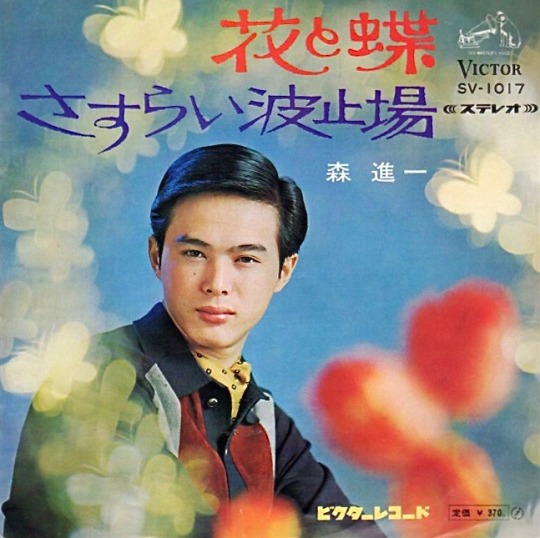
Artist - 森進一 (Mori, Shinichi)
Song - 花と蝶 (Hana To Chō) [Eng. “The Flower And The Butterfly”]
Release Date - May 1968
Listen 🎶
https://rumble.com/v1ym9az-shinichi-mori-hana-to-cho.html
My blog: Showa Music Library
https://nobbykun.tumblr.com/
0 notes
Text
What kind of ability would Higuchi have and its potential name?
Hi to whoever is reading this! This is my first self-written post so I’m still figuring out how all this works and I’m sorry, if it gets a bit chaotic. Anyways, recently, I came across a question regarding Higuchi from Bungou Stray Dogs. It was about what Higuchi’s ability would be called and what type it would be. So I won’t go into details whether she has an ability or not. I believe she has since she is named after an author (and Asagiri himself kinda confirmed it via Twitter). Thus, I just want to write my thoughts on the potential names and kind of ability.
Since abilities in the BSD world are always named after rather well-known works of the authors, I compared some of the famous works of Higuchi Ichiyo. Now mind you, I haven’t read her works myself. I mostly relied on comparing summaries and analyses of them. Since there are not a lot of summaries, I read two lesser-known stories myself. I will add the links of the summaries/analyses of the works down below. However, while comparing I found two works that would fit Higuchi. Now, first what do I mean by “fit”? Well, it might be best to start explaining what I think about the type of Higuchi’s ability.
I believe Higuchi has not an offensive type of ability. Nothing like Atsushi’s, Akutagawa’s, Kyouka’s etc. If she had, I’m sure she would have used it already, since she’s fighting a lot with her guns, why wouldn’t she use her ability as an addition, why would she hide it? There are two possibilities why we haven’t seen her ability yet. First possibility would be that her ability is not visible like Odasaku’s or Ango’s, maybe it’s even an ability that she hasn’t even discovered, just like Fukuzawa hasn’t realized he has one before the ADA. Second would be that she can use her ability only under stringent conditions. And I believe it’s the latter, hear me out.

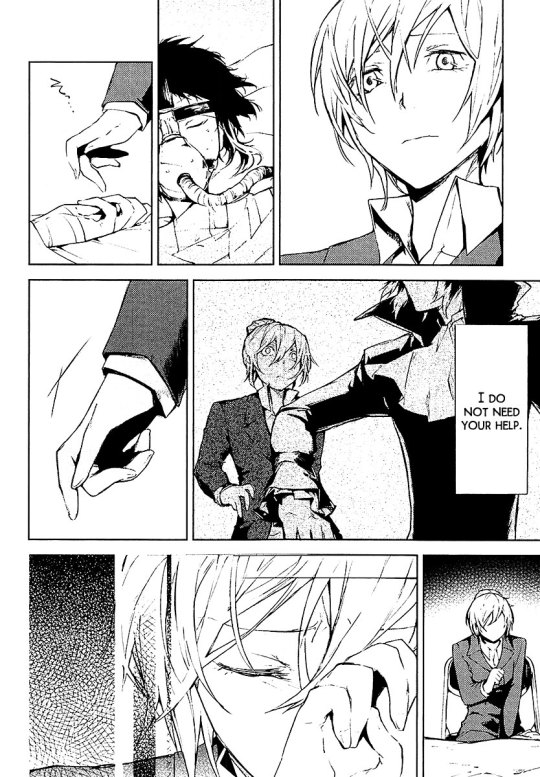
Remember this scene from Chapter 14? Higuchi reaches out to hold Akutagawa’s hand but then pulls back because she remembered him saying that he doesn’t need her help. Now, you could argue that holding the hands of injured loved ones is a gesture of closeness, a way to show them your support, a way to tell them that you’re staying by their side. And Aku doesn’t want this support, so that’s why she retracted her hand. But something bothers me here. In this scene it looks like Aku slapped Higuchi’s hand away, doesn’t it? And then he says, he doesn’t need her help, instead of support. I know, you could say support and help are almost the same. But to me, help is something that you do more “actively”, while support can be something passive. What if Higuchi’s hand represents this “active” help? And what would actively help Akutagawa in this very moment? A healing ability for example. Coincidentally, in the panel before, Hirotsu asks Higuchi what power she posses to make them [the black lizard] obey. Is this a hint that there is a hint about Higuchi’s ability in the next panel? Maybe. But let’s look at the next panel. It’s the title page of this chapter.
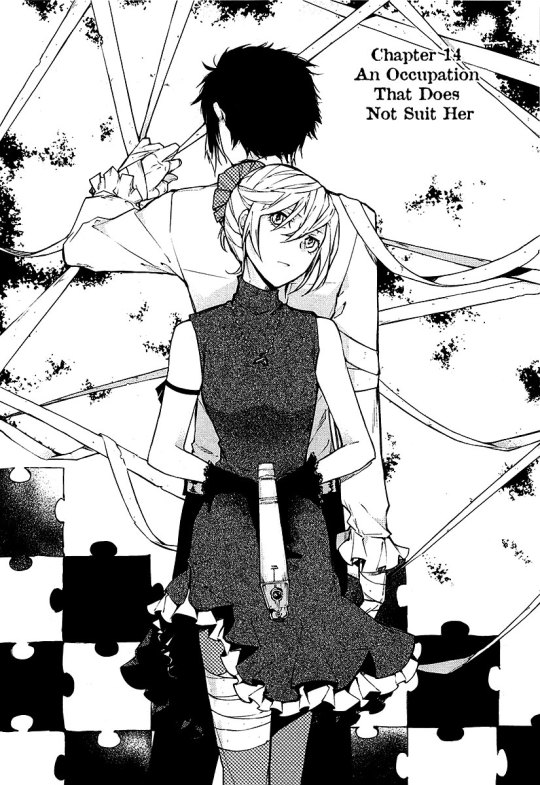
As you can see, Higuchi has a bandage wrapped around her leg and they seem connected to Akutagawa. In this chapter, it is revealed that Higuchi contemplated about leaving the Port Mafia but her reason for staying is implied to be Akutagawa. This is perfectly symbolized by the bandages in this title page. The bandages coming from Akutagawa are holding her leg back, stopping her from walking away from the PM. But maybe there is a second interpretation? If you’re looking at Akutagawa’s left hand, the bandages are starting to come off. What if this means Akutagawa is healing and doesn’t need the bandages anymore? Instead it wraps around Higuchi’s leg, restricting her movement. What if Higuchi’s ability allows her to help someone else (doesn’t have to be necessarily a healing ability) but in exchange she needs to sacrifice something? Anyways, I think she has an ability which allows her to help other people in a non-combat way. With this in mind, I was looking through several works of Higuchi Ichiyo, searching for something that “fits”. Meaning that I was looking for parallels and themes in irl Higuchi’s stories that could be “converted” into an ability. Just like the coat that the protagonist of Rashomon stole in order to now die of hunger was used as Akutagawa’s ability which seems to be able to eat everything, or like the wish that one’s brother does not die in war in Thou Shalt Not Die became Yosano’s ability and serving as a basis of her background story. Anyways, I’d like to present the works that could be used for Higuchi’s ability and draw some parallels.
1. The Thirteen’s Night
The story revolves around a poor woman, called Oseki. Thanks to her marriage to a rich man, her family was able to live a better life and her brother found a job. But on the thirteenth night of the ninth month of the lunar calendar (one of two special nights for moon viewing), Oseki visited her parents with the intention on asking her parents for approval for divorcing her husband. Before entering, she overhears her parents talking about how lucky they are that they have such good children who don’t cause trouble and that they are very thankful for this marriage. Hesitating at first, she finally goes in and admits that she wants to divorce her husband because he abuses her mentally. He insults her constantly and tells her that she's worthless, stupid, and uneducated. Her mother is outraged. But her father, even though he acknowledges her suffering, reminds her what her husband has done for this family and that she would lose her son since women couldn’t get custody of their children after a divorce at that time. Agreeing with her father, Oseki decides to go back to her husband:
“It was selfish of me to think of a divorce. You're right. If I couldn't see Tarō, there'd be no point in living. I might flee my present sorrows, but what kind of future would I have? If I could think of myself as already dead, that would solve everything… Then Tarō would have both his parents with him. It was a foolish idea I had, and I've troubled you with the whole unpleasant business. From tonight I will consider myself dead — a spirit who watches over Tarō. That way I can bear Isamu's cruelty for a hundred years to come.”
– In The Shade of Spring Leaves, translated by Robert Lyons Danly
Just like BSD Higuchi contemplates leaving the PM, the protagonist here wants to leave her husband. The PM is like the husband. It allows her to support herself and probably her family (at least we saw that she has a sister). But there is constant abuse. Akutagawa is clearly the biggest source of abuse that we can see. But it’s not only him. In Chapter 14, Mori asks her if she is really suited for this job. Telling her indirectly that she is useless or that she is too weak for the PM. Later, you can see the Black Lizard doubting her capabilities, even threatening her. But just like Oseki she stays because of a loved one. What really concerns me is Oseki saying that she will consider herself as a dead spirit watching over Tarō. What if Higuchi, in order to use her ability, has to sacrifice part of her lifespan? Or maybe she loses a feeling? Like e.g. she loses the ability to feel happiness, making her a bit more dead inside? If you draw this parallel, you could also say that when ‘consider myself dead’ is the condition of the ability, then ‘watching over Tarō’ is a hint to Higuchi’s ability. An ability that allows her to watch over and protect her loved ones? This theme fits Higuchi perfectly, since a big topic in Higuchi’s story line is how she wants to help and protect Akutagawa. So it makes sense that her ability might be something that would help him (**intensely squinting at the recent events in the manga, especially chapter 88**). Moving on to the second possibility before the pain starts to set in.
2. Takekurabe (literally: "Comparing heights", "Child's Play" in the Robert Lyons Danly translation, "Growing Up" in the Edward Seidensticker translation)
Now this is considered as Higuchi Ichiyo’s masterpiece. So the chances are high that the ability is based on this story. The story accompanies a group of children who live next to the Yoshiwara quarter. There are two rival gangs: the main street gang (’omote-machi’), lead by Shōtarō, a cultivated young boy who is the grandson of the owner of a pawnshop, and the back street gang (’yoko-chō’), lead by Chōkichi, the impulsive firefighter’s son. (Maybe a parallel to the ADA with (cultivated) Fukuzawa and the PM with Mori who’s a doctor which belongs into the same category of occupation as firefighters?). Among the main street gang, there was Midori, popular and pretty, who lives in the brothel where her sister works. Shōtarō probably has a crush on her. But Midori probably has feelings for the other main character, Nobu, the son of a Buddhist priest. Even though he returns her feelings, he distances himself from her out of his self-consciousness. Later he joins the rival gang after repeated request by Chōkichi. Anyways, they spend their days very care-free, attending school, playing with each other after school. One day, some conflict arises between the gangs and Midori, while protecting someone else, gets slapped by Chōkichi with a sandal. He then proceeds to tell her that their gang is backed by no other than Nobu. Midori feels humiliated and stops going to school. Soon she also stops playing with the other children. After some time passed, Midori is seen with her hair all done up. She has become a distant, lady-like young woman. This probably means that she got her first period and is old enough to become a prostitute or that she just had her first client as a courtesan. Little by little, the children grow up. Nobu is sent off to be trained as a priest and Shōtarō has come to accept the responsibilities of his family’s shop.
There are several themes in this story that I’d like to point out, namely unrequited love, Midori’s transformation and underlying unchangeable fates. The first one is obviously a big theme in Higuchi’s story. Midori and Nobu are unable to express their love for each other because of their positions in life. Just like Higuchi is unable to express her feelings for Akutagawa. If you want some hope, AkuHigu shippers, maybe Aku has also feelings for Higuchi but is still very confused and self-conscious about it just like Nobu. Anyways, because of their positions in the PM, it would make everything very complicated if Higuchi confessed. Additionally, Midori feels like she was humiliated by her love when she got slapped by that sandal. I’m sure that Higuchi gets humiliated by Akutagawa a lot. The next theme is Midori’s transformation from a tomboyish to a lady-like, distant woman. We all know Higuchi looks really badass in her suits. But again, look at the title page of chapter 14. Higuchi is dressed up all prettily and lady-like in a dress, and her hair is done all up. Just like Midori after her transformation. Midori’s transformation stands for Midori accepting her occupation as a prostitute even though she doesn’t want to. In this chapter, we see that Higuchi has accepted her job in the PM, even though she doesn’t want to do this job. At the end Shōtarō sings the following:
"Growing up,
she plays among the butterflies
and flowers.
But she turns sixteen,
and all she knows
is work and sorrow."
– In The Shade of Spring Leaves, translated by Robert Lyons Danly
I don’t know about you guys, but to me that necklace that Higuchi is wearing in that title page looks like a butterfly to me. This is really farfetched but maybe this could be a hint about when Higuchi joined the Port Mafia? However, the biggest theme in Takekurabe is the underlying unchangeable fate of the children. Shōtarō was destined to become the next owner of the pawnshop, Nabu was destined to become a Buddhist monk and Midori would become a prostitute. Maybe this gives us some insight into why Higuchi joined the PM? Maybe one of her parents was a PM member? I also like to think that since Aku is in the PM, since she wants to be with him, she can’t but stay in the PM, and this is her fate. Nevertheless, fate is a central theme in Takekurabe. This is the reason why I think, if the ability is based on this story, Higuchi’s ability would be something like changing fates. Changing fate of someone else but in return she must sacrifice something.
Okay, so this post has become quite long. But I still wanted to mention two other stories Yamizakura (Flowers at Dusk) and The Sound of the Koto where I saw a lot of parallels. I just want to briefly tell you the story of The Sound of the Koto. In this story a woman abandons her son in order to leave her husband who has a bad reputation. The husband then turns into an alcoholic and dies later at a party because of alcohol intoxication. The boy becomes hardened to the world, despises his mother for leaving them, and even contemplates suicide. The story shifts then to a woman playing the koto. I want to give you an excerpt for the end of this story:
“On this night the sound of the woman’s playing helped another to be reborn. Through fourteen springs and fourteen autumns, the boy had been buffeted by the rains. His heart had gradually toughened until it had become as hard as stone. No arrow could penetrate it. He seemed destined to follow the example of his father, to die among the fields or in the mountains, where his remains would be bleached by the elements. Some were convinced the boy’s life would end in prison chains, while his bad name spread to every roadside.
But now, at once, the tenderness buried in his heart was freed by the midnight strains of the koto. For the first time in many years, he felt tears come to his eyes. Or were they jewelled drops of dew? He would not exchange them for anything.
He, who had known neither love nor compassion, and who had no idea what the player of these refrains could even look like, felt a moment of happiness as the music drifted over the garden wall. […]
[…] How could a stormy wind blow now? The clouds in his heart had disappeared. Once more the woman began to play. The sound of the koto would be his friend for a hundred years, the seed for a hundred years of yearning. He had entered a world where a hundred different flowers wer in bloom.
– In The Shade of Spring Leaves, translated by Robert Lyons Danly
This boy somehow just reminds me so much of Akutagawa. Just like this boy, without any parents and home, wandering around in this world, Akutagawa has become hardened to the world. I’d like to think that Higuchi’s ability could free Akutagawa from his pain, just like the sound of koto does for this boy.
So, now I said everything I wanted to say, I guess. If there is really anyone reading this and reading this until here, thank you so much! I appreciate it very much that you kept reading even though my thoughts are probably quite chaotic. I’m sorry if there are any grammar mistakes or weird sentence structures or anything like this. English is not my first language. I’m very happy, if you could point out any mistakes or have any suggestion for improvement. Lastly, I just want to remind you that these are my thoughts, I love discussing so feel free to comment your thoughts but I’d like you to keep in mind that there is not necessarily a wrong or right, theories are theories, interpretations are interpretations. Everyone has another interpretation. They can only be proven wrong by Asagiri sensei himself. Until then just keep the discussions friendly and tolerant towards other people’s thoughts and opinions.
Sources:
All manga panels used in this post are from easygoingscans
Higuchi Ichiyo (樋口 一葉)
Higuchi Ichiyo: "In the Shade of Spring Leaves"
In The Shade Of Spring Leaves: The Life Of Higuchi Ichiyo, With Nine Of Her Best Stories, translated by Robert Lyons Danly
In the Shade of Spring Leaves – Ichiyō Higuchi, Part 1
“Flowers at Dusk” and Other Notes – Ichiyō Higuchi, Part 2
“Encounters on a Dark Night” and Other Notes – Ichiyō Higuchi, Part 3
“Child’s Play” and Other Notes – Ichiyō Higuchi, Part 4
HIGUCHI ICHIYŌ: BADASS WOMEN IN JAPANESE HISTORY
The Thirteenth Night (Wikipedia)
Female Subject, Interrupted in Higuchi Ichiyō's "The Thirteenth Night"
GAME OF TRADITIONS: TRADITION IN THE THIRTEENTH NIGHT AND DIARY OF A MAD MAN
HIGUCHI ICHIYŌ IN MODERN JAPANESE AND EUROPEAN DRESS: Modern Japanese versions (gendaigoyaku) of Higuchi Ichiyō’s Takekurabe and their Relationship with English, Castilian Spanish and Catalan Translations
Separate Ways Summary
Literary Analysis of “Separate Ways”
Flowers at Dusk
Nigorie (Wikipedia)
From the Margins of Meiji Society: Space and Gender in Higuchi Ichiyō's "Troubled Waters"
#bsd#bsd manga#bsd theories#bsd theory#bsd higuchi#bungou stray dogs#bsd akutagawa#bsd thoughts#bungou stray dogs theory#bungou stray dogs analysis#bsd analysis#bsd characters#bsd chapter 88#bsd mori#bsd hirotsu#bsd black lizard#port mafia#bungo stray dogs#bsd abilities#higuchi theory#Q overthinks again
431 notes
·
View notes
Text
I deconstruct and rate AiB characters names
Arisu: His first name is Ryōhei (良平) with 良 (ryō) meaning good and 平 (hei) meaning flat. It suits him imo; good of heart and flat of ass 💕 Good boy name 9/10.
Usagi: First name is Yuzuha (柚葉) with 柚 (yuzu) meaning citrus fruit and 葉 (ha) meaning leaf. Pretty name for a nature girl 😍 10/10.
Chishiya: First name is Shuntarō (駿太郎) with 駿 (shun) meaning great, 太 (ta) meaning too many and 郎 (rō) meaning man. Checks out; big ass attitude for such a small man 😤 11/10.
Niragi: First name is Suguru (傑) and it means excel. Excel at being a murderer rapist asshole? At being hot af? I agree 😌 8/10 just because I don’t really like the sound of it lol.
Kuina: Her first name is Hikari (光) and it means light. I can’t begin to explain how much I love her name 😭. Yes baby, you’re a bright shining light ✨ 20/10.
Hatter: His first name is Takeru (剛) meaning strong. Welp, that didn’t last long unfortunately. Still love him, good name so 9/10.
Last Boss: First name is Takatora (隆寅) with 隆 (taka) meaning vigor and 寅 (tora) meaning tiger. Okay so, probably unrelated, but don’t some of his tattoos kinda look like tiger stripes? Well, now they do. Nice name, love tigers, 11/10 ✨
Aguni: First name is Morizono (杜園) with 杜 (mori) meaning woods and 園(zono) meaning garden. Very cute name actually, someone write an Aguni gardener AU please 🌸 9/10.
Karube: First name is Daikichi (大吉) with 大 (dai) meaning big and 吉 (kichi) meaning luck. Not funny, false advertising, made me cry 😭✋. Still 10/10 for best boy.
Chota: His first name is Chota (張太) lol, one of the few characters that is consistently called by his first name. 張 (chō) means stretch and 太 (ta) means tick. Sounds sexual, no comments. He’s kinda cute tho so 8/10 ✨
#alice in borderland#ima wa no kuni no alice#the way i bet no one cares about this but i still think it's interesting#arisu ryohei#usagi yuzuha#chishiya shuntaro#niragi suguru#kuina hikari#danma takeru#samura takatora#aguni morizono#karube daikichi#segawa chota
390 notes
·
View notes
Text
Japanese Addresses
The structure of the Japanese address or 住所 (じゅうしょ) is different from addresses in most parts of the world. Only the main streets in the cities have names, and individual buildings may not have numbers. The order of the address is written opposite to most English-speaking addresses - the Japanese postal code comes first while the street number comes last.
Large cities like Tokyo and Osaka are divided into 区 (く) or wards.
区 are divided into 町 (ちょう) which are towns or neighborhoods.
町 are divided into 丁目 (ちょうめ) or districts.
丁目 are divided into 街区 (がいく) which are city blocks.
街区 then have separate 番号 (ばんごう) or building numbers.
The address for the Tokyo Metropolitan Oizumi Central Park is:
〒178-0061 東京都 練馬区 大泉学園町 9丁目4−3
The post code is 178-0061.
The city is Tokyo (東京都), read Tokyo-to, meaning the Metropolis of Tokyo.
The ward is Nerima-ku (練馬区).
The neighborhood is Ōizumigakuen-chō (大泉学園町).
The district is 9-chōme, the city block number is 4, and the numbered address is 3 (9丁目4−3).
However, addresses don’t always include all of these parts, especially in smaller towns, or even within Tokyo itself. For example, the address for the Mori Art Museum in Tokyo is:
〒106-6150 東京都 港区 六本木 6丁目10−1, 六本木ヒルズ森タワー, 53階
Here you will find the post code, the city (Tokyo-to), and the ward (Minato-ku) just as before, but there is no -町, just Roppongi (六本木) and then the address numbers (6丁目10−1) and the building name ( 六本木ヒルズ森タワー or Roppongi Hills Mori Tower) and floor (53-kai). Oftentimes, the 丁目 is dropped and the address numbers would simply read 6-10-1.
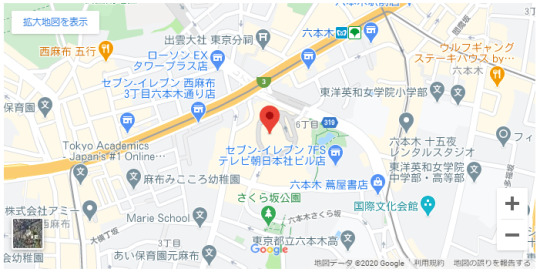
Note: When you address a letter to Japan (or even within Japan), addressing it in the Latin alphabet or ローマ字 is perfectly acceptable. It is also acceptable to address it in the Western format, with the street address first and the post code last. If you address it in the Japanese format, the name of the person to whom you are sending the post would be last, with their name followed by the formal honorific -sama (様).
#日本語#japanese#japanese language#japanese langblr#langblr#studyblr#住所#japanese address#tokidokitokyo#tdtstudy
342 notes
·
View notes
Text
Japanese Literature
Henlo there demons, it’s ya boi, Nyah Lajom.
East Asia is where you'll find China, Hong Kong, Japan, Macau, Mongolia, North and South Korea, and Taiwan.
In this blog, I will be talking about the prevalent themes of literature in Japan throughout the history.
Long ago, the Japanese citizens farmed together in harmony and then everything changed when the Portuguese empire attacked. They brought a brand new religion from the far far west, Catholicism, and new innovations like guns and gun powder.
In antiquated writing, just like in the Philippines, information is passed down orally, this implies that over the long haul, some of it is lost or changed. However, at that point, writing was introduced to Japan by the Chinese via Koreans.

ANCIENT LITERATURE (8th Century)
(ᴘʟᴇᴀꜱᴇ ɴᴏᴛᴇ ᴛʜᴀᴛ ʜᴇ ᴛɪᴍᴇʟɪɴᴇ ɪ ᴜꜱᴇᴅ ɪɴ ᴛʜɪꜱ ᴘᴇʀɪᴏᴅ ɪꜱ ᴜɴᴏꜰꜰɪᴄɪᴀʟ)
The most established enduring works are the Kojiki and Nihon Shoki, the two books were passed down through oral literature.
Kojiki (Record of Ancient Matters) is a book about the myths and legends of Japan.
Nihon Shoki (Chronicles of Japan) is the chronological record of history.
Both works were from early 8th Century and are government projects.

CLASSICAL LITERATURE (794-1185)
During the Heian Period, the nobles and rich were fascinated by the Chinese culture, respectable men utilized the Chinese language similarly that Medieval European aristocrats and ministers utilized Latin. In Heian Japan, women were not permitted to speak Chinese. (Misogyny was rampant at the time)
Early 11th Century, Murasaki Shikibu wrote the world’s first novel, The Tale of Kenji. The novel enables us to see how aristocrats live because it’s about a man named Kenji and his gag with women and nobles. It is said that The moral of the story is that affection isn't about the craving of having intercourse with some ladies or about the battle to overcome every single pretty woman. Be that as it may, love should be kept with a lady we love for eternity.
Genji shows how extraordinary the thing that matters was between the sexual orientations by having characters experience passionate feelings for one another dependent on their penmanship.

Mid 10th Century, Tosa Hiromichi wrote Taketori Monogatari. The story details the life of Kaguya-hime, a princess from the Moon who is discovered as a baby inside the stalk of a glowing bamboo plant.
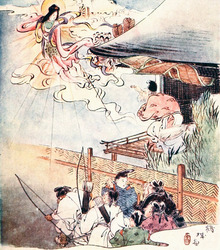
MEDIEVAL LITERATURE (1185-1600)
The Medieval Literature was basically Japan having civil wars and books were all about it.
An example of this is Taiheiki (Chronicle of Great Peace), composed in the late 14th century, is a Japanese historical epic and covers the period from 1319 to 1367. It deals mainly with Nanboku-chō, the time of conflict between the Kyoto Ashikaga Takauji Northern Court and the Yoshino Southern Court of Emperor Go-Daigo.
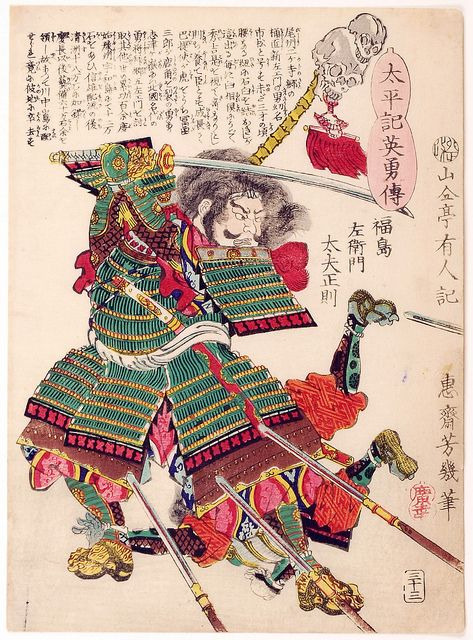
The dominant theme in this era is Zen Buddhism. It’s about life, spirituality, and existence. The writers in this time tackled more on existential crises and death. It’s like the Greek philosophers but make it ✨ j a p a n e s e ✨
Let me give you another example of writers and their work. Yoshida Kenko's Tsurezuregusa (Essays in Idleness) and Kamo no Chomei's Hojoki (An Account of My Hut) just like I said earlier, the question of eternal redemption is posed by both works.
(Tsurezuregusa)
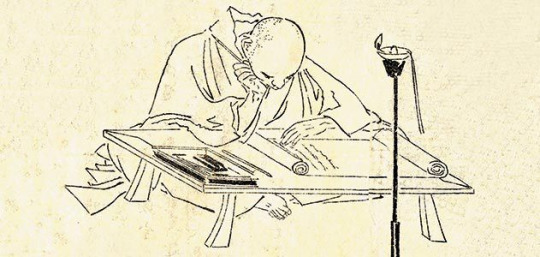
(Hojoki)

EDO PERIOD (1600-1868)
The Edo period was really the rise of popular culture in Japan. Increased leisure time gave the rising merchant class a chance to explore things like bathhouses, the theater, and reading. A lot happened in this era so I’m gonna summarize it.
The position of literature as a means of social intercourse expanded.
Haiku is perfected and seen as the embodiment of elegant simplicity.
In the new capital of Edo (modern Tokyo), due in large part to the growth of the working and middle classes, types of common drama emerged that would later evolve into Kabuki.
Literacy rate rose.
The introduction of Chinese vernacular fiction which has shown the greatest external effect on the production of Japanese fiction in the Early Modern period.
In the development of the Yomihon, which were historical romances almost entirely in prose, Tsuga Teisho, Takebe Ayatari, and Okajima Kanzan were instrumental.
Santo Kyoden wrote Yomihon, often set in gay quarters, before such works were banned by the Kansei edicts, and he turned to comic Kibyoshi. Genres included horror, stories of crime, stories of morality, satire, and pornography, frequently accompanied by colorful prints of woodcut.
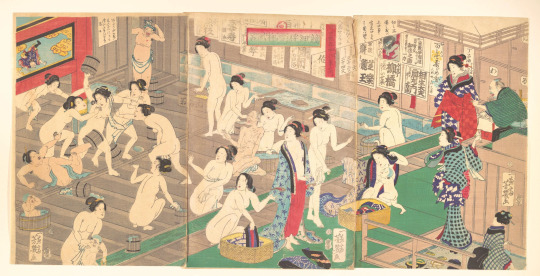
MEIJI PERIOD (1868-1945)
The Meiji Period parkoured over themes so I’m just gonna put the timelines and its dominant themes.
1868-1880′s Realism is the dominating literature theme. In a simple style between literary and colloquial, Ichiyo Higuchi, a rare woman writer in this period, wrote short stories about powerless women of this generation.
1889-1905 Romanticism was brought in by Mori Ogai, and hen Toson Shimazaki carried it to its height.
1906-1910 Naturalism, Shimazaki shifted to Naturalism, this describes the authors themselves and depicts their own mental states.
1920-1930 Socio-political created by Takiji Kobayashi, Denji Kuroshima, Yuriko Miyamoto, and Ineko Sata portrays the harsh lives of laborers, peasants, women, and other downtrodden members of society and their struggles for change.

Meiji Period in a nutshell.
POST-WAR PERIOD (1945-Present)
After the WWII, Japan was defeated and many expressed their disaffection, loss of purpose. The predominant theme in is Socio-political commentary then in the early 1980′s popular fiction became the mainstream theme until now.

Nyah Lajom
4 notes
·
View notes
Photo
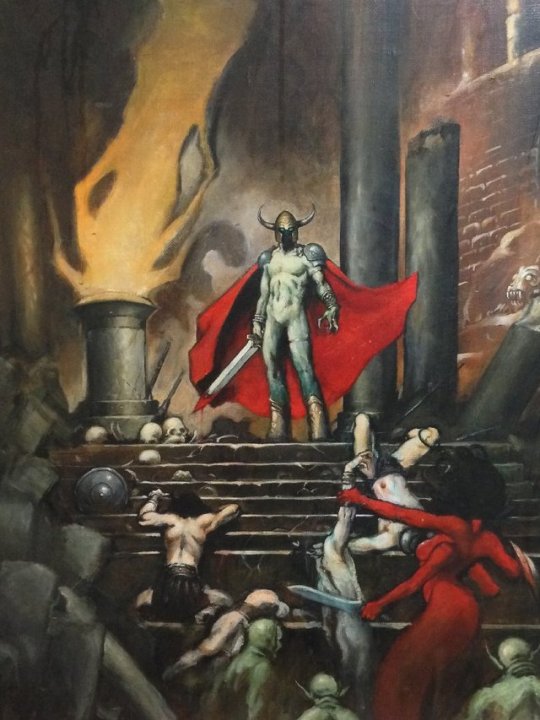






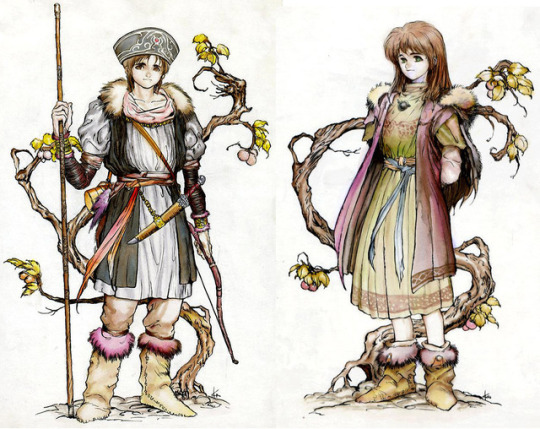


Kensuke Suzuki / 鈴木健介, AKA Hiroshi Kajiyama / 梶山浩 (? - July 12, 2018) Part 1: 1989-1994
Part 2:
http://videogamesdensetsu.tumblr.com/post/175911626865/kensuke-suzuki-%E9%88%B4%E6%9C%A8%E5%81%A5%E4%BB%8B-aka-hiroshi-kajiyama-%E6%A2%B6%E5%B1%B1%E6%B5%A9
https://twitter.com/KAJIYAMA_
http://www.pixiv.net/member_illust.php?id=1238858
http://www.hqsweb.com/
https://web.archive.org/web/20000919194756/http://www.cyborg.ne.jp:80/~hq_hp/
https://enty.jp/hqs_kajiyama
https://h-kajiyama.tumblr.com/
Kensuke Suzuki started his career in the 80s as an illustrator, designing cover art and illustrations for games, tabletop RPGs and magazines such as Warlock. In parallel with his Western-influenced style --he took inspiration from artists such as Frank Frazzeta and Jeffrey Catherine Jones -- he developed another style in the early 90s and signed these works under a different name: Hiroshi Kajiyama. He used both names in his early years in the video game industry (where he also worked as a graphic designer), then signed all of his works Hiroshi Kajiyama.
He directed the video game company Rit's under what (GDRI and) I assume is his real name: Kensuke Suzuki.
He is mostly known in the West for his work on the Shining Force series but also worked on games such as Golden Sun as a chara-designer (the character illustrations were made by Shin Yamanouchi).
He worked on a lot of adult games and illustrated many erotic mangas (one of them has been published in France earlier this year).
On July 14, 2018, his son posted a message on Twitter saying that his father passed away. He was working on the manga Curse Blood as well as on a comic based on the Chinese game The Soul of Hunter.
Games featured above:
1) Dark Wraith / ダークレイス (PC-98 - 1989) cover art
2) Dragon Warrior II (NES - 1990) cover art
3) Wardner no Mori / ワードナの森 (Mega Drive - 1991) cover art
4) Cyber Dodge / サイバードッジ (PC Engine - 1992) cover art, chara design
5) Dragon Master Silk - Ryuu Shoukan Musume - Episode II / ドラゴンマスターシルク~龍召還娘~ Episode2 (PC-98 - 1992) cover art, planning, scenario, chara-design, graphic design
6) Shining Force Gaiden / シャイニング・フォース外伝 遠征・邪神の国へ (Game Gear - 1992) cover art, chara-design
7) Shining Force Gaiden: The Sword of Hajya / シャイニング・フォース外伝II 邪神の覚醒 (Game Gear - 1993) cover art, chara-design
8) Moldorian / モルドリアン (Game Gear - 1994) cover art, illustrations, chara-design
9) Stronghold ~Kōtei no Yōsai~ / ストロングホールド ~皇帝の要塞~ (PC-98, FM-Towns - 1994) cover art
10) Shining Force CD / シャイニング・フォースCD (Mega-CD - 1994) JPN cover art
Games he has worked on:
Blue Garnet / ブルー・ガーネット (PC-98 - 1994) illustrations
Chō Heroin Senki / 超ヒロイン戦記 (PS3, PS Vita - 2014) chara-design (K-86X)
Cyber Dodge / サイバードッジ (PC Engine - 1992) cover art, chara design
Dark Wraith / ダークレイス (PC-98 - 1989) cover art
Darkness Again (Windows) cover art, illustrations, chara-design
Dragon Master Silk - Ryuu Shoukan Musume - Episode II / ドラゴンマスターシルク~龍召還娘~ Episode2 (PC-98 - 1992) cover art, planning, scenario, chara-design, graphic design
Dragon Master Silk / ドラゴン マスター シルク (Saturn - 1995) cover art, planning, scenario, character design
Dragon Master Silk II / ドラゴン マスター シルクII (PC-98 - 1995) cover art, planning, scenario, chara-design, graphic design
Dragon Master Silk 1&2 / ドラゴン マスター シルク1&2 (Windows - 2002) cover art
Dragon Warrior II (NES - 1990) cover art
From the Darkness ~Injuu Genmu~ / from The Darkness ~淫獣幻夢~ (Windows - 2002) cover art, illustrations
Injuu Genmu 1&2 / 淫獣幻夢1&2 (Windows - 2000) cover art, illustrations
Injuu Genmu III: Nasty Angel / 淫獣幻夢III~Nasty Angel~ (Windows - 2001) cover art, illustrations
Magicians Dead / マジシャンズデッド (Arcade - 2016) enemy design
Moldorian / モルドリアン (Game Gear - 1994) cover art, illustrations, chara-design
Ōgon no Taiyō: Hirakareshi Fūin / 黄金の太陽 開かれし封印, AKA Golden Sun (GBA - 2001) chara-design (with Shin Yamanouchi), enemy design
Ōgon no Taiyō: Ushinawareshi Toki / 黄金の太陽 失われし時代, AKA Golden Sun: The Lost Age (GBA - 2002) enemy design
Ōgon no Taiyō: Shikkokunaru Yoake / 黄金の太陽 漆黒なる夜明け, AKA Golden Sun Dark Dawn (DS - 2010) chara-design (with Shin Yamanouchi), enemy design
Queen's Gate ~ Spiral Chaos ~ / クイーンズゲイト〜スパイラルカオス〜 (PSP - 2011) Last boss design, CG
Queen's Blade ~ Spiral Chaos ~ / クイーンズブレイド〜スパイラルカオス〜 (PSP - 2009) middle boss design, in-game illustrations
Raika ~Kasenkyuu~ / 蕾花 ~花仙宮~ (PC-98 - 1994) illustrations
Shining Force CD / シャイニング・フォースCD (Mega-CD - 1994) JPN cover art
Shining Force Gaiden / シャイニング・フォース外伝 遠征・邪神の国へ (Game Gear - 1992) cover art, chara-design
Shining Force Gaiden: The Sword of Hajya / シャイニング・フォース外伝II 邪神の覚醒 (Game Gear - 1993) cover art, chara-design
Shining Force Gaiden: Final Conflict / シャイニング・フォース外伝 ファイナルコンフリクト (Game Gear - 1995) cover art, chara-design
Shining Force III Scenario 1: Ōto no kyoshin / シャイニング・フォースIII シナリオ1 王都の巨神 (Saturn - 1997) chara-design (with Shin Yamanouchi), enemy design
Shining Force III Scenario 2 ~Nerawareta Miko~ / シャイニング・フォースIII シナリオ2 狙われた神子(Saturn - 1998) chara-design (with Shin Yamanouchi), enemy design
Shining Force III Scenario 3: hyōheki no jashingū / シャイニング・フォースIII シナリオ3 (Saturn - 1998) chara-design (with Shin Yamanouchi), enemy design
Shining Wisdom / シャイニング・ウィズダム (Saturn - 1995) cover art, illustrations
Stronghold ~Kōtei no Yōsai~ / ストロングホールド ~皇帝の要塞~ (PC-98, FM-Towns - 1994) cover art
Sugoventure: Dragon Master Silk Gaiden / すごべんちゃー 〜ドラゴンマスターシルク外伝 (Saturn - 1998) cover art, graphic design
The Darkness (Windows) cover art, illustrations, chara-design
Wardner no Mori / ワードナの森 (Mega Drive - 1991) cover art
unreleased Dungeon crawler
To be confirmed:
Fire Emblem Fates: Birthright (2015) Movie Facial Supervisor
Fire Emblem Fates: Conquest (2015) Movie Facial Supervisor
Mahjong Princess Go! Go! / 麻雀プリンセスGO!GO! (PC-98 - 1995)
Sword Art Online: Lost Song (2015)
Tokyo Mirage Sessions ♯FE (2016) Animation Supervisor
Other video game related works:
Dragon Quest II: Rondarukia no Akumu (dōjin)
Last Chronicle / ラストクロニクル (TCG - 2013) Card Illustrations, developed in parallel with Last Chronicle Online
Logout Table Top RPG Special / ログアウトTRPGスペシャル (Magazine - March 1993) cover art
The Soul of Hunter / 猎魂觉醒 (comic - 2018) based on an eponymous Chinese game
Sources:
Pen Name
https://twitter.com/daza_e5656/status/499435833938550784
Rit's (company)
http://gdri.smspower.org/wiki/index.php/Rit's
Passed away on July 12, 2018
https://twitter.com/dankanemitsu/status/1018072446014877696
Frazetta
https://twitter.com/KAJIYAMA_/status/486427966780346368
Step by step illustration
https://twitter.com/KAJIYAMA_/status/852599238726868992
https://twitter.com/KAJIYAMA_/status/852599348059713536
unknown
https://twitter.com/KAJIYAMA_/status/869865392981721088
https://twitter.com/KAJIYAMA_/status/470937986779983872
https://twitter.com/KAJIYAMA_/status/855978184663105536
unreleased Dungeon crawler
https://twitter.com/KAJIYAMA_/status/853293499419992065
https://twitter.com/KAJIYAMA_/status/485489965426835456
https://twitter.com/KAJIYAMA_/status/868592737519403009
https://twitter.com/KAJIYAMA_/status/799219419012419584
Unused characters
https://twitter.com/KAJIYAMA_/status/802115509021863936
https://twitter.com/KAJIYAMA_/status/802115403019218944
iOS game
https://twitter.com/KAJIYAMA_/status/900823156117602304
https://twitter.com/KAJIYAMA_/status/868592657483808768
https://twitter.com/KAJIYAMA_/status/868592431272296448
https://twitter.com/KAJIYAMA_/status/741418739938140160
Saturn game
https://twitter.com/KAJIYAMA_/status/892742275125526531
Blue Garnet: A-WORKS, via:
https://e-hentai.org/g/198031/6d68e27f6c/
Chō Heroin Senki
http://dengekionline.com/elem/000/000/811/811750/
Cyber Dodge
https://twitter.com/gdri/status/983474739372060672
Curse Blood (manga)
https://twitter.com/KAJIYAMA_/status/887651441900310529
Dark Wraith
https://twitter.com/KAJIYAMA_/status/980133594667495424
Darkness Again
https://www.suruga-ya.jp/product/detail/ZHOI9939
Dragon Master Silk
https://twitter.com/i/web/status/923177684062035969
https://twitter.com/KAJIYAMA_/status/988828174539603968
https://twitter.com/KAJIYAMA_/status/989489235886465025
https://twitter.com/KAJIYAMA_/status/989486473429708800
https://twitter.com/KAJIYAMA_/status/980111302461804550
https://twitter.com/KAJIYAMA_/status/470925412541812736
https://twitter.com/KAJIYAMA_/status/584753498929016833
https://twitter.com/KAJIYAMA_/status/1009509104367251456
Dragon Master Silk Gaiden
https://twitter.com/KAJIYAMA_/status/947753116694233090
Dragon Quest II: Rondarukia no Akumu
http://www.hqsweb.com/Trial/DQ2_BOR_sample.PDF
https://twitter.com/KAJIYAMA_/status/841210782431903744
https://twitter.com/KAJIYAMA_/status/841210881593630720
https://twitter.com/KAJIYAMA_/status/848210024576950272
https://twitter.com/KAJIYAMA_/status/848210218693480448
https://twitter.com/KAJIYAMA_/status/848215746207399936
https://twitter.com/KAJIYAMA_/status/848215907516137473
Dragon Warrior II
https://twitter.com/KAJIYAMA_/status/980164041891971072
HQ's A-works (dojin)
http://g.e-hentai.org/g/198031/6d68e27f6c/
Half Quarter Book One (dojin)
http://g.e-hentai.org/g/718345/3bb6b0961e/
https://twitter.com/KAJIYAMA_/status/947776764259975168
Injuu Genmu series: RB Works (1) via:
https://e-hentai.org/g/192515/e0cfd90fc1/
Last Chronicle
http://www.last-chronicle.jp/cardsearch/result.php?q%5Billustrator%5D=梶山浩
https://twitter.com/KAJIYAMA_/status/865543558157049857
https://twitter.com/KAJIYAMA_/status/825055980580855809
https://twitter.com/KAJIYAMA_/status/825055863895240705
https://twitter.com/KAJIYAMA_/status/753880198660009984
https://twitter.com/KAJIYAMA_/status/753880717516353536
https://twitter.com/KAJIYAMA_/status/675257570785812480
Logout March 9, 1993
https://twitter.com/kajiyama_/status/486126186192326657
https://twitter.com/kajiyama_/status/486126186192326657
Magicians Dead
http://www.comic-ryu.jp/_curseblood/
Moldorian
https://twitter.com/KAJIYAMA_/status/978970127696674816
Ōgon no Taiyō series: in-game credits
Queen's Blade ~ Spiral Chaos
http://www.comic-ryu.jp/_curseblood/
Queen's Gate ~ Spiral Chaos
http://www.comic-ryu.jp/_curseblood/
Raika ~Kasenkyuu~ : RB Works (2) Raika, via
https://e-hentai.org/g/39012/c9da25455b/
Role Playing Game no tatsujin
https://twitter.com/KAJIYAMA_/status/992199653041963008
Shining Force Gaiden series: in-game credits, Half Quarter
Shining Force CD: in-game credits, Half Quarter
Shining Force III
https://twitter.com/KAJIYAMA_/status/955650811513614336
https://twitter.com/KAJIYAMA_/status/955649701331714048
Shining Force III.2
https://www.shiningforcecentral.com/?p=artwork&id=sf3sc2
Shining Force III.3
https://www.shiningforcecentral.com/?p=artwork&id=sf3sc3
https://twitter.com/KAJIYAMA_/status/955650811513614336
https://twitter.com/KAJIYAMA_/status/955649701331714048
Shining Wisdom
https://www.shiningforcecentral.com/?p=artwork&id=sw
https://twitter.com/KAJIYAMA_/status/892035809112506368
https://twitter.com/KAJIYAMA_/status/892038015203201027
https://twitter.com/KAJIYAMA_/status/892038115111469056
Stronghold ~Kōtei no Yōsai~
https://twitter.com/KAJIYAMA_/status/992200136490082305
The Darkness
https://www.suruga-ya.jp/product/detail/ZHOI9939
The Soul of Hunter
https://mp.weixin.qq.com/s/K194EJ1MkSzM2FnjciDg2A
Wardner
https://twitter.com/KAJIYAMA_/status/992199653041963008
Warlock
http://doublecrown.under.jp/gamebook/introduction/4-390-80010-8.html
http://doublecrown.under.jp/gamebook/introduction/4-390-80012-4.html
354 notes
·
View notes
Text
Moji goi bunpō o manabu tame no jissen renshū nōto
New item:

Shelf: 817.5 BES B
Moji goi bunpō o manabu tame no jissen renshū nōto : "Nihon ga wakaru, Nihongo ga wakaru" junkyo.
edited by Tanaka Yūsuke hencho ; by Ushikubo Ryūta, Chin Shūin, Mori Atsushi, Koguchi Yukiko, Chō Yue.
Tōkyō : Bonjinsha, 2021.
ISBN: 9784893589859
181 pages ; 26 cm. + 1 answer booklet (32 pages).
Includes bibliographical references (page 179).
Text in Japanese.
0 notes
Text
CRAZY NIGHT by SMILEY*2G’s YU(KAN/ROM/ENG) lyrics
シャンデリアの 森をかけてく 蝶たち
Shanderia no mori o kakete ku chō-tachi
The butterflies in the chandelier forest
束の間だけ キミとボクは恋人だ
Tsukanoma dake kimitoboku wa koibitoda
For a short time, you and I are lovers
札束だけを 悩ましげにからませて 微笑む
Satsutaba dake o nayamashi-ge ni karama sete hohoemu
Just entangle the bills and smile(?)
ボトルのコルクあけた音で
Botoru no koruku aketa oto de
With the sound that opened the cork of the bottle,
恋を はじめよう
Koi o hajimeyou
Let's start love!
*CRAZY NIGHT!
ALL OF THE NIGHT!
フロアに響く シャンパンコール
Furoa ni hibiku shanpankōru
Champagne call resonates on the floor
CRAZY NIGHT!
ALL OF THE NIGHT!
グラス音たてて
Garasu oto tatete
The sound of the glass.
CRAZY NIGHT!
ALL OF THE NIGHT!
とびっきりの 夢見せるよ
Tobi kkiri no yume miseru yo
I can dream of it.
CRAZY NIGHT!
ALL OF THE NIGHT*
一夜限りのFANCY NIGHT!NIGHT!NIGHT!
Ichiya kagiri no FANCY NIGHT! NIGHT! NIGHT!
FANCY NIGHT for one night only Night! Night!
琥珀色の海を飲み 干す華たち
Kohakushoku no umi o nomi hosu hana-tachi
Flowers that drink the scarlet sea
キスを語る その唇誰のもの?
Kisu o kataru sono kuchibiru darenomono?
Talking kisses, whose lips?
境界線を引いたつもり 余裕の唇に
Kyōkai-sen o hiita tsumori yoyū no kuchibiru ni
I'm going to pull the border on the lips of the margin.
グラスの 泡はじける音
Gurasu no awa hajikeru oto
The sound of popping bubbles in a glass
愛をはじめよう
Ai o hajimeyou
Let's start love!
CRAZY NIGHT!
ALL OF THE NIGHT!
最大音量の ミュージックで
Saidai onryō no myūjikku de
With the loudest music
CRAZY NIGHT!
ALL OF THE NIGHT!
スキを囁いて
Suki o sasayaite
Whispering of love
CRAZY NIGHT!
ALL OF THE NIGHT!
ひそかに 足と足絡んで
Hisoka ni ashi to ashi karande
Secretly with your feet
CRAZY NIGHT!
ALL OF THE NIGHT!
今夜限りの
FANCY NIGHT!NIGHT!NIGHT!
Kon'ya kagiri no FANCY Night! Night! Night!
For tonight only, FANCY NIGHT! NIGHT! NIGHT!
アラビアナイト 千夜一夜
Arabianaito sen'yaichiya
A thousand and one Arabian nights
真夏の幻に 愛と恋との屈析率
Manatsu no maboroshi ni ai to koi to no kitsuritsu
In the midsummer vision, the rate of desegregation between love and love
魔法をかけて
Mahōwokakete
*REPEAT*
I miss you every champagne night
tonight tonight tonight
https://ameblo.jp/naitounatume/entry-11382783618.html
1 note
·
View note
Text
MORI'S REGULAR LOOK
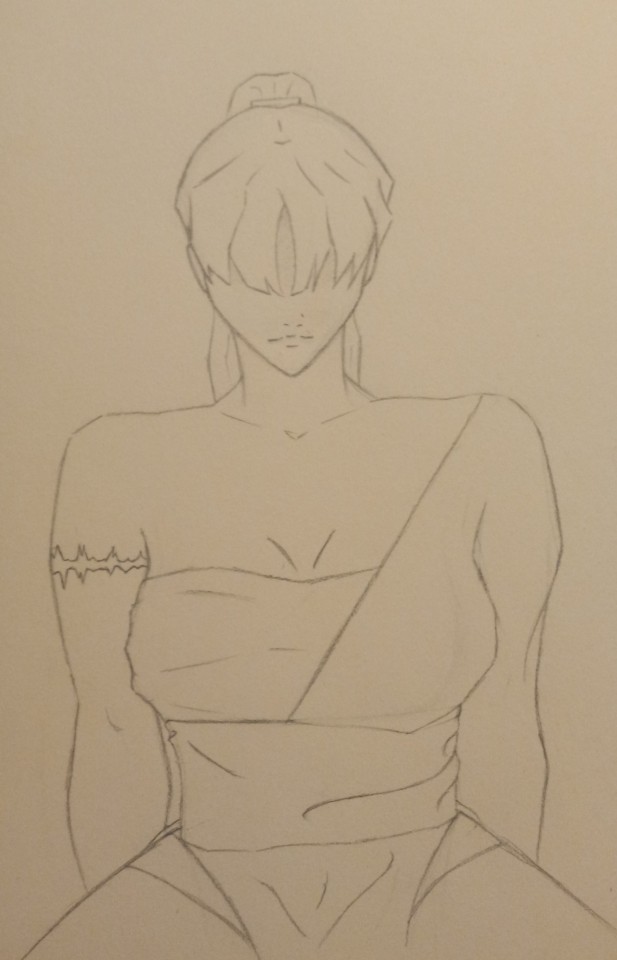
The scar is from when she was a human. She was attacked by a demon and her arm got torn off. When she was turned into a demon it grew back but it left the scar
#Mori Chō#oc talk#my oc#kny oc#my art#her fit was inspired by Susamaru (kny) and Reiden (genshin impact)
1 note
·
View note
Text
Re did it on paper and it feels somuch better

She's a little messy with her food 🤭
1 note
·
View note
Text
Chō Mori (kny oc)

She goes with Muzan when he's under fake identities as his "maid". I'll draw her in her regular clothing later on. I'm gonna go back to drawing on paper because digital is kicking my ass
8 notes
·
View notes